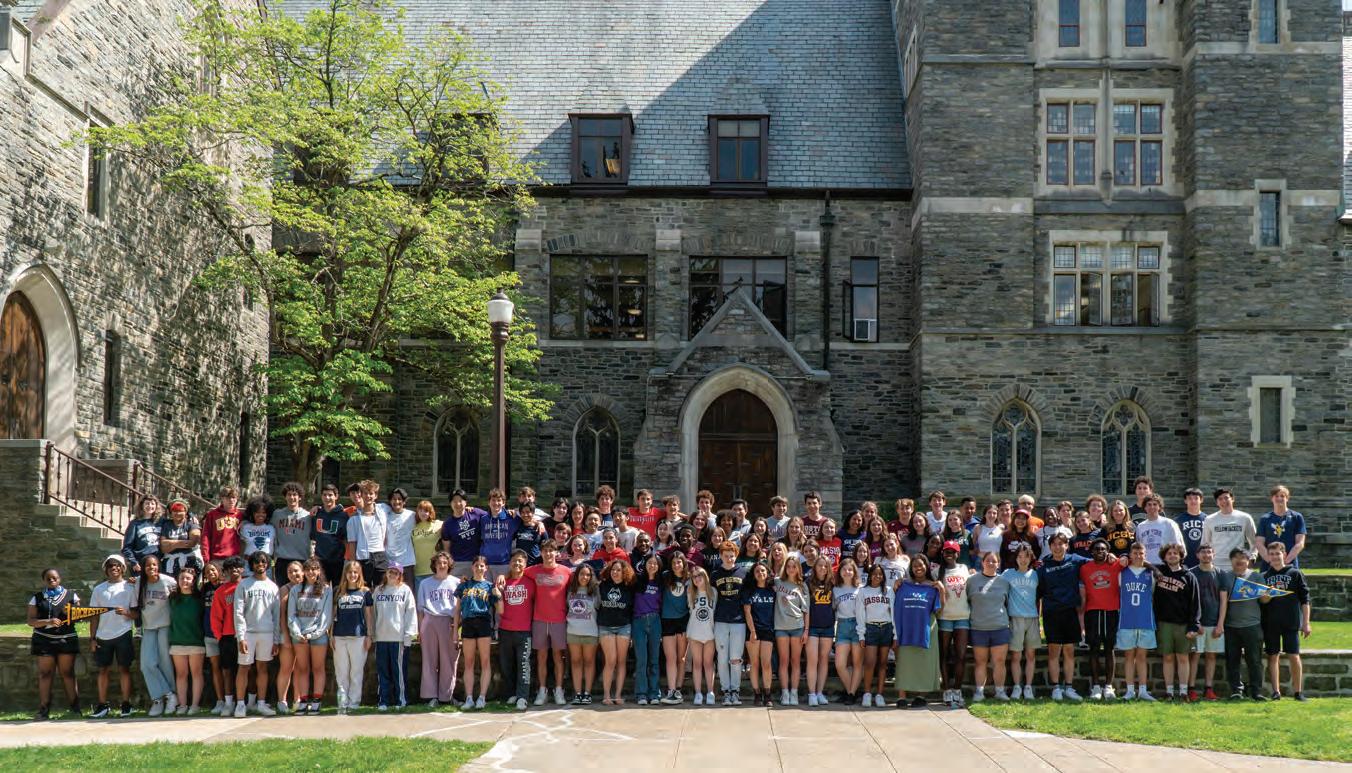
Finding Purpose
ON THE COVER
Melissa
’73
the
Photo: Tristan Greszko




Melissa
’73
the
Photo: Tristan Greszko


With its continual motion and endless flurry of activity, the world tugs at us, demanding our attention. It spins us around, distracting and disorienting us. It’s alarmingly easy to lose our way. How do we find our bearings? How do we keep our focus? Each of us needs to create an internal compass, a sense of meaning and purpose. Only when we are so equipped can we make our way forward as powers for good in the world.
Stanford University’s William Damon, a leading researcher on the development of purpose, has found that one’s life purpose has three components. First, it’s a long-term calling, act or way of life that interests you. Second, it’s something in which you have worked to develop some competence. And this: It makes a difference in the world.
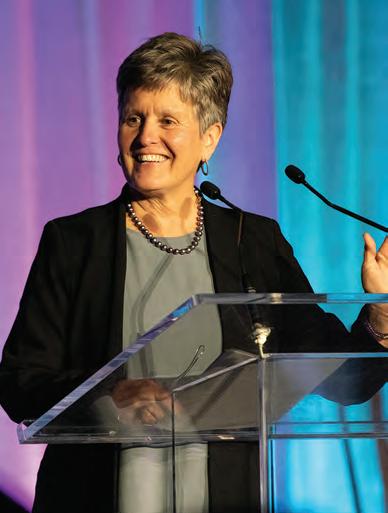
A masters education sets our students on the path to purpose with the tools they need to discover the where and why
“Making a difference” need not entail a giant splash, headline news — or even becoming a “leading researcher.” That said, our job as adults in the lives of students is to give them the fullest possible opportunity to develop their
LETTER to the EDITOR
I was quite pleased to see a photo and write-up about Ruth Nichols in a recent issue of the magazine. Our daughter graduated from Masters in 2015, and we look forward to reading The Bulletin.
Nichols is one of the unsung heroes of the aviation age, overshadowed, unfortunately, by her friend and competitor in the skies, Amelia Earhart.
purpose — in meaningful work, in the nourishment of family, and in their lives as conscientious citizens.
As James Baldwin once said: “Children have never been very good at listening to their elders, but they have never failed to imitate them.” Thus, our job is to model for them how it looks and feels to be alive with purpose.
At Masters, we do this by holding tight to the compass of our mission: “to be a power for good.” I’m honored to work alongside consummate educators who are alive with purpose, committed to their disciplines and to their work with our students. Our teachers strive for what I frame as “equal parts affection and accountability,” where a sense of belonging, ethical behavior, and learning to learn have equal billing with striving to achieve. A Masters education sets our students on the path toward a sense of purpose that is their own. As we watch with awe and pride, they will take it from there.
With gratitude,

Laura Danforth Head of School
I did extensive research on Nichols for my book of popular history, Westchester: History of an Iconic Suburb (McFarland Publishers, 2019). She was a remarkable figure whose tenacity and grit were an inspiration to women when such figures were uncommon.
Seeing the write-up reminded me that I should send a copy of the book to the library, where I
hope it may further an interest in an aviation pioneer and Masters alumna. There is an abundance of social history in the book, as well as many other fascinating stories about lesser-known residents and their connections to seminal moments in American history. I hope all of it will inspire students to learn more about the county around them.
Robert Marchant
In this issue of The Bulletin, you’ll meet members of our Masters community who have found the motivation that gives their life a sense of direction. They attribute this strong sense of purpose to their experiences at 49 Clinton Avenue.
Take melissa malm ’73, Jackson Hole’s first female ski patroller. She recalls how Dobbs taught her “how to learn and stay curious” which helped her jump into new experiences with confidence. Those new experiences involved handling explosives for avalanche mitigation and knowing how to respond for a mountain rescue.
John mcAuliff ’10, a senior advisor on climate at the U.S. Department of Agriculture, says his teachers at Masters taught him to think long term and to understand history and his place in it.
Karen Feinberg dorsey ’84 credits Masters not only with helping her find her purpose as an engineer, but also with preparing her to lead in a field that even now attracts relatively few women.
Feminist, activist and creative strategist Treasure Brooks ’17 graduated 33 years after Karen, but her message echoes a similar sentiment: “Masters equips us with everything we need to be the people we didn’t know we wanted and need to be in the world.”
Like John, rising senior Bobby callagy ’24 is passionate about climate and the environment. He is not waiting for his high school diploma to make a difference in the world. He has found purpose in drafting two environmental bills that are in committee in the Connecticut state legislature.
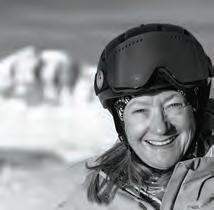


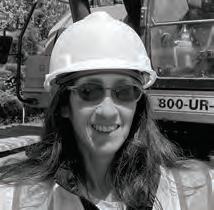
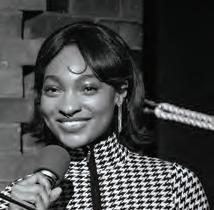
MMelissa Malm’s future was more than a little hazy when she graduated from The Masters School in 1973.
Two of her senior quotes in a well-worn copy of a Masterpieces yearbook, however, bring into focus an unconventional and exciting life that would see her find purpose and transform those around her in the process.
“A group always represents what is common to its members, the common man in man, and never what is individual.”
-Mary Esther Harding, American psychoanalyst
“Come on,” said Christopher Robin.
“Where?” said Pooh.
“Anywhere.” - A.A. Milne, “The House at Pooh Corner”
With a strong sense of teamwork and an undying thirst for adventure, Malm was always poised to break the mold and inspire in whatever career path she chose. That path just so happened to ascend 4,350 feet into the Rocky Mountains in Jackson Hole, Wyoming, where Malm became the first woman to be hired by the Jackson Hole Ski Patrol in 1978.
“I was friends with one of the patrollers and the position opened up and he said I should apply for it,” Malm said, recounting how she initially got the job. “I did, and I was hired. It wasn’t easy. It’s a much more civilized group of people now and there’s a lot more women. I definitely had to prove myself, and I think that’s where the belief in yourself comes into play.”
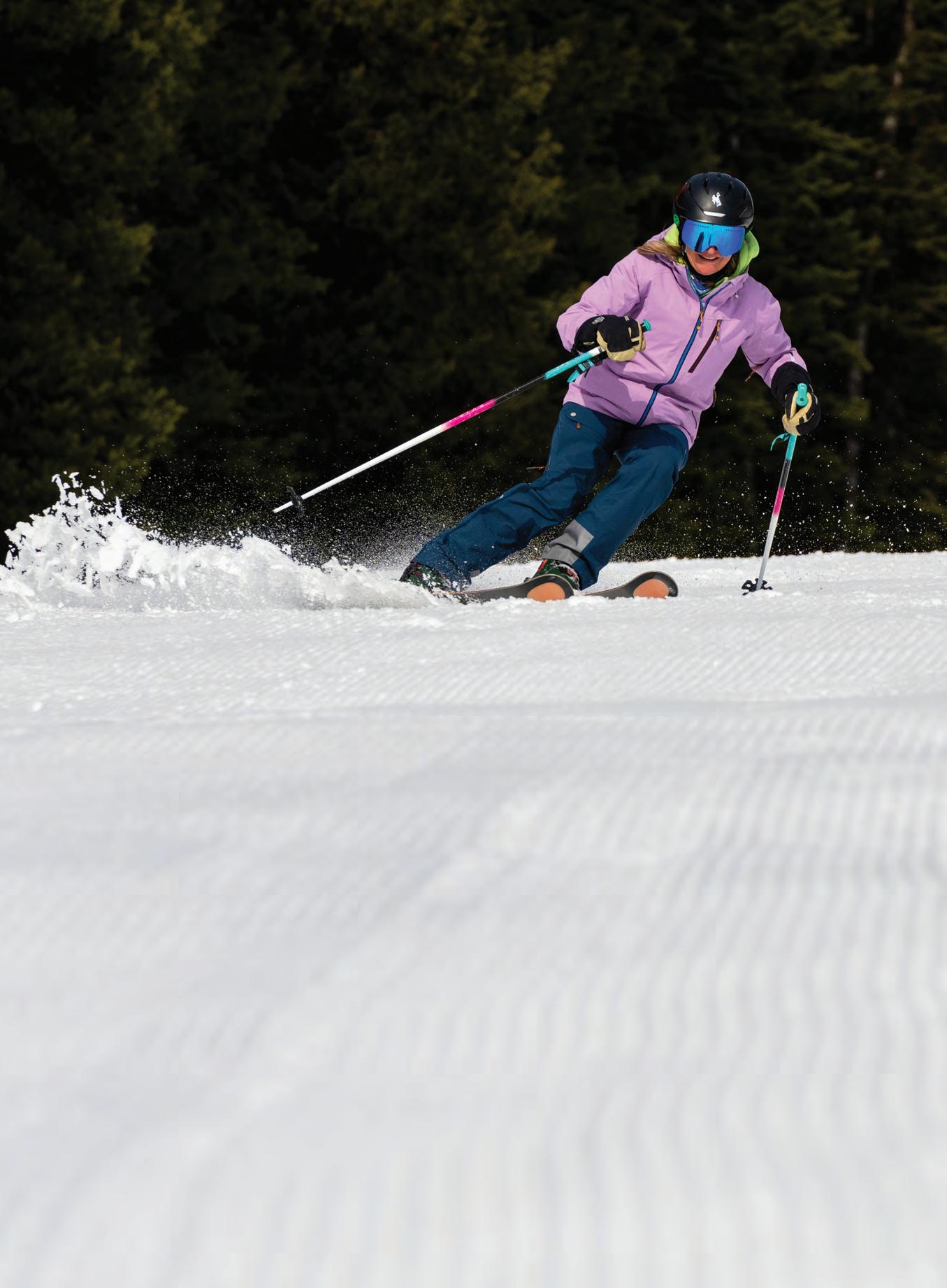
The seeds of camaraderie, belief and perseverance were all planted during Malm’s tenure at Masters, which was still an all-girls school at the time. Malm’s sisters, Betsy Malm Holdsworth and Sarah Malm, also graduated from Dobbs in the Classes of 1970 and 1982 respectively.
“We were all team players in a way,” Malm said. “For me personally, because I wasn’t a straight-A student, or top of the class, the teachers all still saw potential in their students and encouraged each student in their own way. If they saw your potential and talents, they helped you out to go in that direction. Just having teachers believe in you is huge.”
A thirst for knowledge stuck with Malm long after she left 49 Clinton Avenue, allowing her to pick up the advanced aspects of patrolling that included avalanche mitigation with explosives and emergency response/mountain rescue protocols.
“Dobbs taught me how to learn, and to be and stay curious, which has helped me over the years to jump into new experiences with confidence,” she said.
Malm, a former day student from nearby Irvington, New York, recalled wanting to pursue modern dance, biology or nursing in college. But the number one requirement for a prospective university was more about location than degrees and diplomas.
“It had to be near skiing,” said Malm, who was bitten by the ski bug as a child while learning the sport alongside former Masters classmate Ibbits Warriner Newhall ’73 at nearby Sterling Forest in Tuxedo, New York.
Dobbs taught me how to learn, and to be and stay curious, which has helped me over the years to jump into new experiences with confidence. ” “

With that in mind, Malm settled on the University of Utah. She pointed her skis westward and never looked back, embarking on a life of discovery and learning.
At the University of Utah, Malm met a friend from Jackson Hole and frequently visited the area. She spent a few summers in the resort town and was eventually lured and hooked like a Snake River trout on a fly-fishing line.
“I said I was ‘taking a year off’ as kids sometimes do," Malm said. “But I never went back.”
Initially, Malm worked as a “first-aider” in Jackson Hole, an unpaid position with the ski patrol. She was then promoted to a full-time paid position following an injury to another member of the patrol.
The sheer danger and grueling nature of life as a ski patroller always stuck with Malm, who started the Jackson Hole Ski Patrol Memorial Scholarship Fund with a colleague in 2011 to memorialize patrollers of the past.
“We saw an opportunity to honor ski patrollers who had gone before us and passed away,” she said. “I think everyone in their profession learns from those who went before them. So that’s
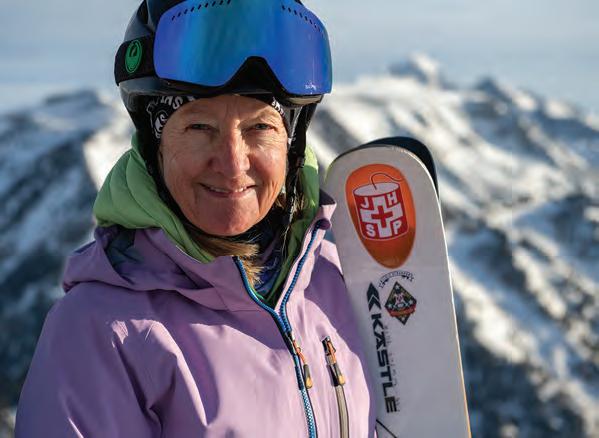
where we were coming from with the memorial part of the scholarship.”
The fund awards annual scholarships to local high school students to offset future educational costs. Malm dutifully reads through all the student-submitted essays each year to pick the winners.
“This particular class really showed a lot of resilience because they had the COVID years during high school, which was really hard,” she said. “We always try to give to a variety of students — whether it’s to go to vocational school or in the past we’ve paid for wilderness EMT classes. Most of these kids this year are going on to college.”
Malm no longer works on the mountain as a patroller, but she left an indelible mark on the team. Her attention to detail in terms of safety protocols and emergency care was crucial in helping the patrol flourish and grow.
After all these years in Jackson Hole, Malm is still close to the action. She currently works in a medical clinic at the base of the mountain as a liaison, helping with paperwork and assisting the nurses.
“I fill in doing that,” she said. “It’s not a fulltime job. It’s hard to give up. They still tolerate me being around.”
As for her trailblazing career path to become Jackson Hole’s first female ski patroller, well, don’t expect her to brag about it.
“I don’t take total credit or feel like I’m this amazing ski patrol woman,” Malm said. “I was in the right place at the right time and I had the right attitude and could ski well. I was open to learning. This was the door that opened for me.
“I do feel that I have been an example to other women in this community. You can do this job. You might not be as strong as men as far as physically doing the job, but I’ve always found that women can be more nuanced in the way they approach things. They find their own way of doing the same job, but they do it a little differently.”

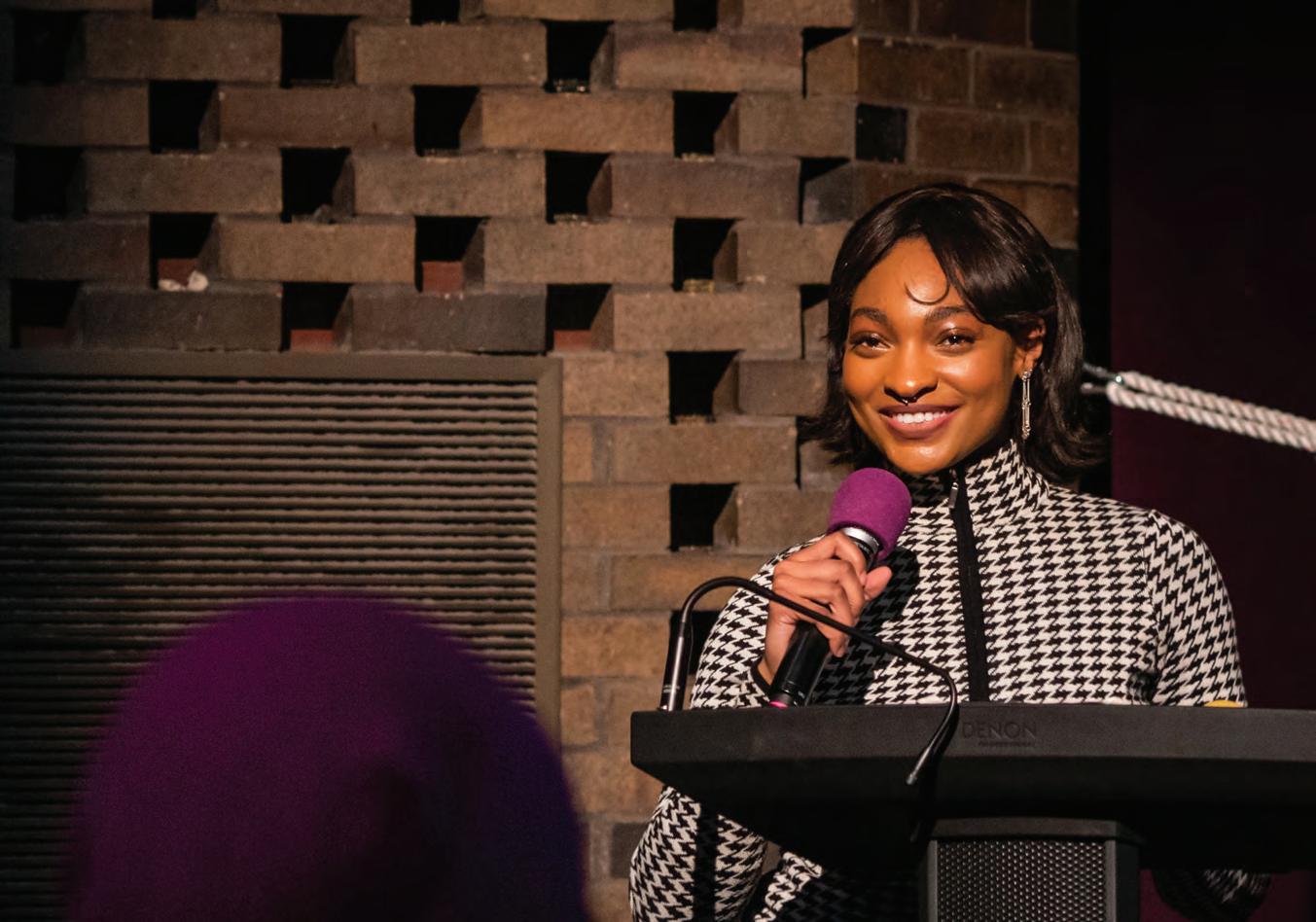
At Masters, Treasure Brooks ’17 discovered her voice. Now, she’s using it to advocate for change.
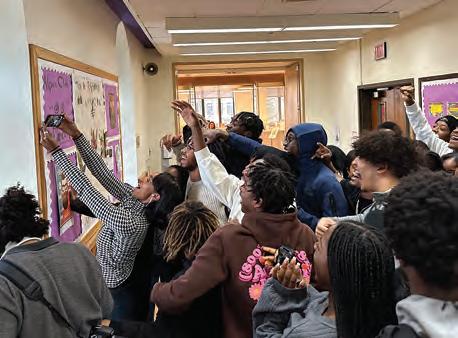
IIs there anything Treasure Brooks ’17 can’t do?
“Swim and ride a bike,” she admits.
For someone who never learned the backstroke, Brooks is adept at diving into the metaphorical deep end. After all, this is the woman who, during her senior year at Harvard, abruptly switched her visual arts thesis from film to metal.
(Did we mention that Brooks had no idea how to weld?)
“I taught myself metalworking, I made a bunch of sculptures, and I put up my first exhibition,” she says.
Her thesis, “Sleep Under Ladders,” was a multimedia exhibition that “explored how people misattribute systemic oppression to individualized bad luck,” Brooks says. It won three of Harvard’s most prestigious awards, and the theory behind it formed the basis of the book Brooks is currently writing — a combination of personal essays, cultural criticism and social theory.
While in college, Brooks co-founded The Meteor, a feminist media company launched under the direction of Cindi Leive, former editor-inchief of Glamour and Self magazines. The Meteor’s mission is to utilize “the power of storytelling, journalism and art to advance the freedom and dignity of all women.” Brooks has directed, edited and been
Masters equips us with everything we need to be the people we didn't know we wanted and need to be in the world. ” “
featured in work for Teen Vogue, Audible, Harper’s Bazaar, TED, The Hollywood Reporter and various academic journals.
Prior to her work in media, Brooks clerked at the Baltimore City Public Defender’s office and was a legal intern with the Shepherd Higher Education Consortium on Poverty. She is now a frequent speaker on U.S. public policy, socioeconomic inequity and racial injustice.
A rising star who has already made her mark on the media world, Brooks looks back on her time at The Masters School as formative. It was there she learned one of the lessons she has taken with her on every step of her journey: “I’m entitled to speak my mind. And actually, I have something worthwhile to say.”
A Springbo A rd for g rowth
Brooks grew up in Oakland, California, the youngest of four children. Her mother found Masters through A Better Chance, a nonprofit that connects students of color with some of the nation’s top public and independent schools.
“I was a dancer, and the big differentiating quality of Masters was the arts programming, which was and continues to be exceptional,” Brooks says. “I had gone to performing arts school all my life, so Masters was a place that my mom felt I could continue my training.”
“Seeing that students were empowered, that the teacher sat at the same table,” convinced Brooks that Masters was the school for her.
When she arrived on campus in fall 2013, Brooks was placed in a triple in Cole Dorm with a student from Bulgaria and a student from China. The experience was eye-opening.
“Speaking to our parents on the phone at night, you heard three different languages,” she explains. “That exposure to hearing people speak fluently in two other languages every single day, and in the most intimate, loving voice you can hear another language, it made me a more cultured person.”
Through her connections with fellow boarding students from across the globe, “I grew a fondness for the world,” Brooks says. “The world felt like a safe place for me after I’d left Masters.”
The sisterhood she developed with her dormmates stays with her to this day: “I feel as strong a sense of pride for them as I do my birth siblings. I really do. Because we raised each other. We raised each other for four years.”
finding h E r SU p E rpow E r Brooks credits MISH with empowering her to see herself as a community organizer — a skill she has utilized when, for example,
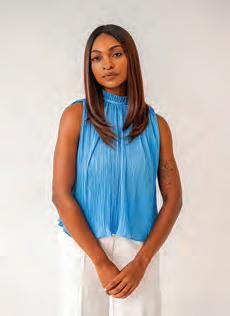
leading nationwide initiatives advocating for expanded resources and protections for low-income and first-generation college students.
One day while preparing kits for homeless individuals that would be distributed during a Midnight Run, she questioned why feminine hygiene products were not in the packages. In response, MISH held a drive for feminine hygiene products. “That became my introduction to major organizing, which created the momentum for everything today,” Brooks reflects.
“Masters made me feel as though it was okay to speak up,” Brooks says. “When I went to college, that was my magic trick. It really was a superpower in the world.”
At Masters, Brooks flexed that superpower by taking on numerous leadership positions: class president for three years; co-chair of Onyx, the Black empowerment club; diversity ambassador; president of Urban Connection, the step group; Dance Company choreographer; middle school peer leader; and dorm proctor.
She recalls one moment in Darren Wood’s English class that taught her self-sovereignty. Wood had tasked the students with a particularly challenging assignment, and in typical teenage fashion, the students protested. Wood calmly replied, “Oh, you don’t have to do the homework.” Brooks thought, “Thank goodness. Now he’s coming to his senses.” But Wood continued: “You don’t have to do the homework, but you will get a bad grade if you don’t.”
For Brooks, that moment “affirmed, first and foremost, our innate agency as people,” she explains. “He taught us there will be repercussions for your choices. And being taught that idea of consequential action at 15, it changed everything for me. Some things I am willing to accept the consequences of not doing.”
On a trip to campus in March, Brooks spoke with the Upper School about her journey from 49 Clinton Avenue to her career as an artist, theorist, author and creative strategist. She described how Masters taught her to lean into the nagging suspicion that she had her entire life: “That I am powerful.”
“Masters equips us with everything we need to be the people we didn’t know we wanted and need to be in the world,” Brooks says.
Although Brooks’ future is an open book, one thing is certain: She’ll tap into her superpower and continue to make her voice heard.
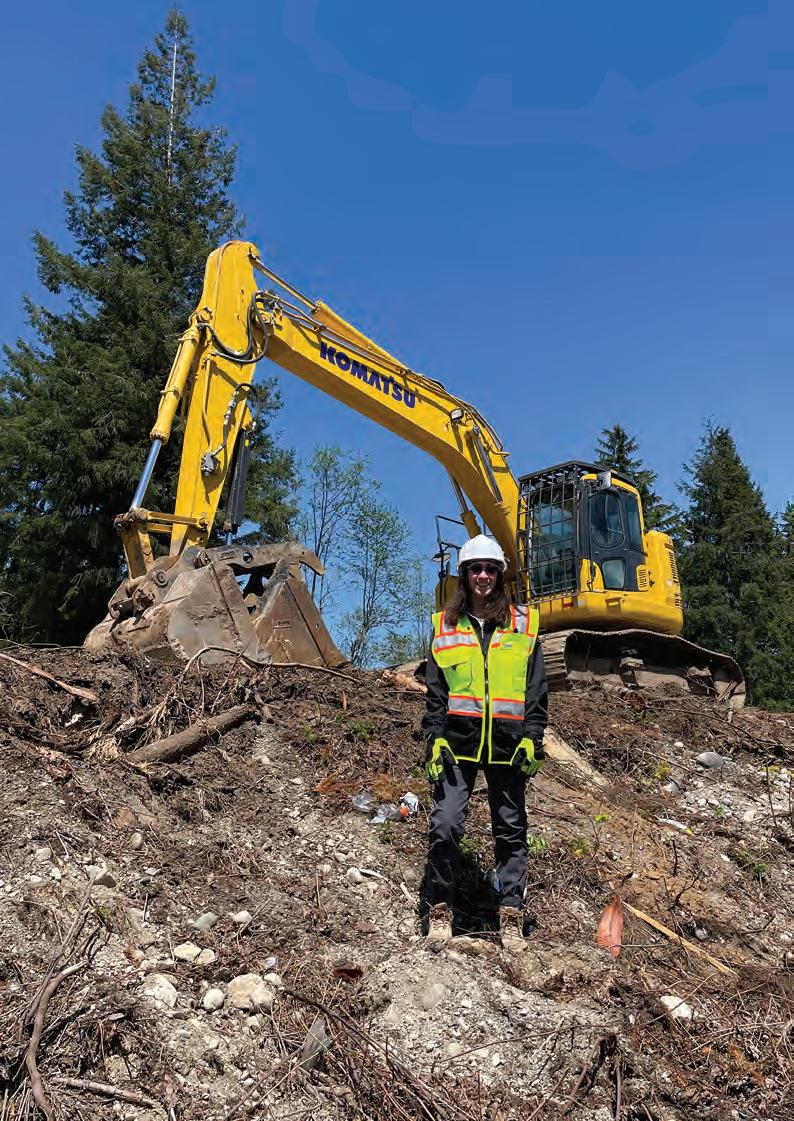
BELOW: Thanks to a Dobbs guidance counselor, Dorsey learned about engineering as a profession.

Whenever Karen Feinberg Dorsey ’84 drives to or from the Seattle-Tacoma Airport with her husband, she likes to point out particular overpasses and connectors. “I built this,” she’ll say proudly.
A civil engineer, Dorsey has spent her career in what’s known as heavy civil construction, working on the expansion or rehabilitation of large public projects such as wastewater treatment plants and highways. Earlier in her career, she supervised construction in the field; now she’s a project manager with a larger set of responsibilities. High-profile jobs she’s worked on include the AirTran at John F. Kennedy International Airport in New York and the Oculus Transportation Hub in Lower Manhattan.

How a pre-college meeting at Masters led Karen Feinberg Dorsey ’84 to uncover a passion for civil engineering.
Engineering fits Dorsey the way a bit might fit a drill, but it’s a career she didn’t know existed until her junior year, when her college guidance counselor asked if Dorsey had ever considered engineering.
“I knew the engineer drove the train,” Dorsey said. “That’s what I knew about engineering at the time.” She had always been a selfdescribed math and science geek. “When I was young, I would take apart anything I could find and try and put it back together, sometimes successfully, sometimes not. But for Susan Moriarty, director of college guidance, I would not have known what to do with that.”
Dorsey credits Masters not only with helping her find her purpose as an engineer, but also with preparing her to lead in a field that even now attracts relatively few women. As recently as 2020, only 14% of civil engineers were women, according to the American Society of Civil Engineers.
Dorsey, who attended Masters when it was all girls, said she and her classmates were encouraged to express their thoughts freely. “You didn’t have to necessarily raise your hand if you had something to say. You could just say it,” she recalled. That experience accustomed her, she said, to “feeling that what I think, and my opinions, and how I think about something, is valuable and worth saying,” and has led to a commitment to supporting and empowering women in construction.
When she graduated from Lafayette College in 1988 and began working, Dorsey often felt overlooked in meetings, even when she had a point to make. “I just did not let that stop me because I felt like I have something valuable to add, and I will keep saying it until somebody hears me,” she said. “I think a lot of that is from the experience at Masters.” She noticed many of her female colleagues did not share that confidence. At Skanska, one of the world’s largest development and construction firms where she worked from 1998 until 2019, Dorsey became an unofficial sounding board.
“I would get phone calls from women, and sometimes it was just, ‘I feel like I’m the only woman and nobody really understands, or, I know you can relate to this.’ I said, ‘I want to find a way to connect these women and let everybody know they’re not the only one.’”
She began by organizing informal gatherings in New York City. The group expanded and this, along with Dorsey’s involvement with the Diversity and Inclusion Council, led the firm to form its first employee resource group, the Skanska Women’s Network (SWN). Dorsey relocated to the Seattle area in 2012 and chaired SWN’s Northwest chapter. Now a project manager at Aecon, the Canadian developer
she joined in 2019, Dorsey is on the steering committee for Aecon Women in Construction.
Dorsey is also involved with the National Association of Women in Construction and Women’s Transportation Seminar, occasionally speaking on their panels. At Skanska, she helped spearhead the firm’s involvement with a high school mentoring program. “It’s really a passion of mine to get young women to be excited about engineering and even know that it exists and is an opportunity,” she said. “I want more people to get to experience building things, because there’s nothing better.”
“
I have something valuable to add, and I will keep saying it until somebody hears me. ”
Just as something clicked for Dorsey when she discovered engineering, something clicked the first time she arrived at Masters. “I could tell that I could be my genuine self,” she said. That impression proved true, and the feeling of acceptance and inclusion persisted. During her three years at Masters, Dorsey played field hockey and lacrosse and was a member of the Dobbs Athletic Association. She also served as a work proctor and dorm proctor, and gave tours through the Gold Key Society. “I just think it’s the most incredible place,” she said. “I would not do what I do and I would not be where I am if I hadn’t gone to Masters. There is no doubt in my mind.”
JJohn McAuliff ’10 always knew he wanted to work in government. He often thinks about a conversation he had as a student at Masters. “A friend attempted to dissuade me from public service because she had it on good authority that ‘Seven rich guys make all the decisions in the world,’” McAuliff says.
Good thing he didn’t take her advice.
As the senior climate advisor for rural development at the U.S. Department of Agriculture (USDA), McAuliff is making an impact on environmental policy by shaping and implementing programs that build renewable energy systems across the country.
His portfolio includes the Renewable Energy for America Program, which provides grants and loans to farmers and rural small businesses so they can actualize renewable energy systems or make energy efficiency improvements; biofuel programs; energy pilot programs; and programs that decarbonize rural electric cooperatives.
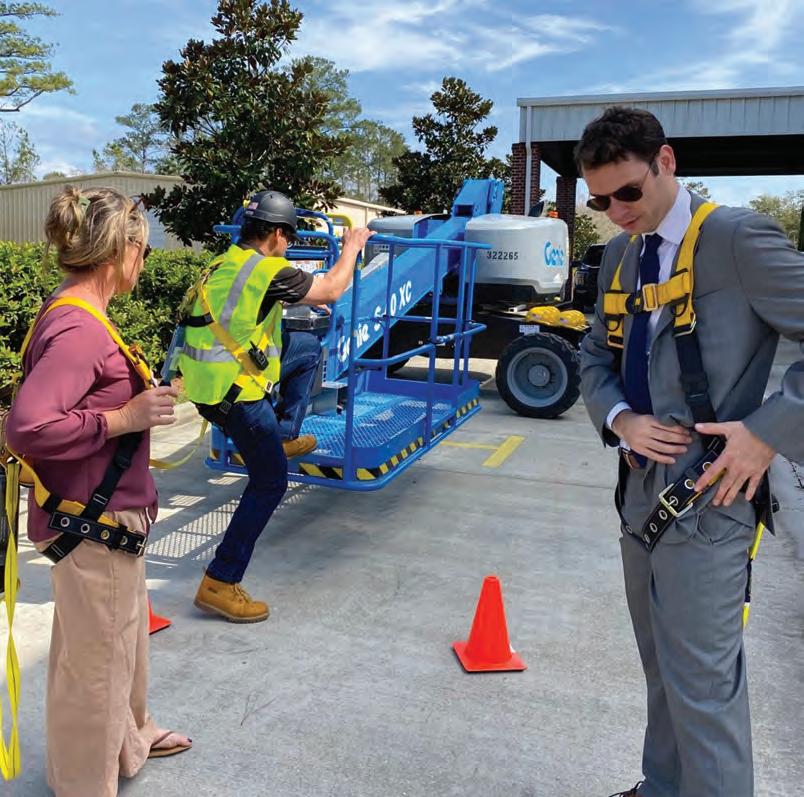
In short: reducing greenhouse gas emissions in a way that is feasible for and beneficial to farmers and small business owners in rural areas.
McAuliff describes his day-to-day work as “one part program design for the Department of Agriculture's energy programs, one part hype man for those programs, and one part subjectmatter expert.”
A trip this year to Louisiana included meetings with the rural development state director’s team, an announcement of $5 million in new federal investments in the state, and a visit to an award-winning American flag solar panel array. “Climate resilience is essential throughout the country,” McAuliff says. And rural areas like southern Louisiana “remain a priority for ensuring the climate transition is equitable and impactful.”
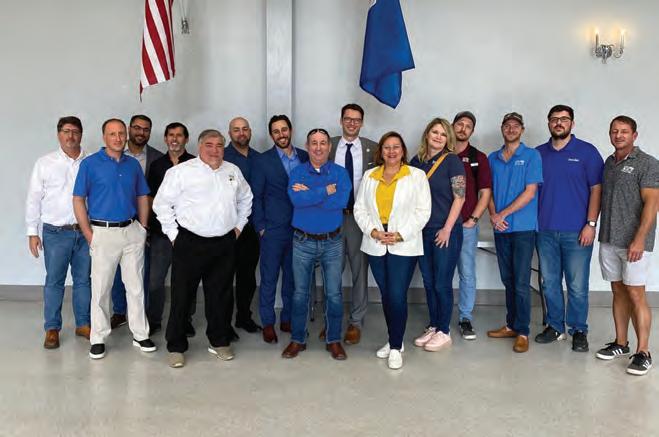
ABOVE LEFT: Safety first: McAuliff preparing to ride a lift to check out an award-winning solar panel array in Covington, Louisiana.
LEFT: McAuliff, center back row, acknowledges “the epic lift being done by our rural development state directors and their staffs, as well as our national office team” around climate resilience.
“Most days my work provides meaning and purpose when it is often hard to come by in today's world,” he adds. “I know I make an impact, if only a small one.”
Saying “Yes”
McAuliff’s route to the USDA wasn’t linear. “I don't really believe there is a way to plan a career,” he shares. “I just kept saying ‘yes’ to everything throughout my 20s until I couldn’t anymore.”
At Masters, he was class president and involved with Model UN and MISH — all activities that reflect his interest in politics, policy and service to others. He wrote for Tower, the School’s award-winning studentrun newspaper, and was on the fencing team.
McAuliff looks back with fondness on his time at Masters. Citing upper school history and religion teachers Matthes Ives, Ellen Cowhey and Lisa Berrol as significant influences, he says, “They taught me how to think long term, to understand history and our place within it, and view everything I do through an ethical lens.”
The most important lesson he learned during his four years at Masters?
“Everything in our world — good and bad — that didn’t precede humanity was built by someone just like you,” he says. “And everything in it will, without a doubt, be changed by someone like you. Masters equips students with the tools to be the ‘yous’ changing it for good.”
McAuliff didn’t exactly say “yes” to the college that became his alma mater, the University of Richmond. He was rejected by 11 of the 12 colleges he applied to and was waitlisted at Richmond. “I eventually got off the waitlist and attended,” McAuliff says. “It was a humbling experience, but Masters prepared me well to roll with the punches and find my way back.”
After his first year in college, he pursued a burgeoning desire to discover more about the United States.
RIGHT: He doesn’t just talk the talk, he walks the walk. John McAuliff took a semester of college off to build and install wind turbines in Peru.
“I packed up my little white Toyota Camry and traveled the country, writing stories for USA Today College and keeping a blog. (This was cool 10 years ago, I swear),” he says. At some point on his journey, his father shared an opportunity that piqued his interest: Would he want to join a group of engineers who needed help building wind turbines in Peru?
“Yes.”
The six-week stint turned into several months: “I realized I was not that compelled to go back to school,” McAuliff says, “so I left for a semester and joined the group in the highlands of Peru near a small town called Huamachuco, where we installed the turbines.”
The job was challenging and enlightening. “I was by no means an engineer, and I recall this was the first job I took on where I was working with my hands every day,” McAuliff explains. “I discovered a different kind of confidence in myself and my abilities, brushed up on my Spanish, and learned that there is always a niche you can carve for yourself as long as you keep your eyes out for something that needs doing.”
When he came back to the United States, McAuliff returned to the University of Richmond and completed his degree in leadership studies — but not before adding White House intern to his resume in the summer of 2013.
He then said “yes” to a host of opportunities including a Coro Fellowship in public policy; the Governor’s Fellows Program in Virginia when Terry McAuliffe was governor; and roles on Hillary Clinton’s 2016 presidential campaign and Ralph Northam’s 2017 campaign for governor of Virginia. McAuliff also worked for Virginia State Delegate David Reid, Joe Biden’s 2020 presidential campaign, and Clean Virginia, an organization that promotes clean energy

and community control over energy policy in Virginia.
Throughout these experiences, he found time to start a small digital media firm, open a bed-and-breakfast and earn a masters certificate in biotechnology from Georgetown University.
And when the call came asking him to join the USDA, that was an easy “yes.”
Reflecting on the value of a Masters education, McAuliff says: “You’re extremely well positioned to succeed in the world, and because of that you have a responsibility to do something useful in it.”
That, without a doubt, is a call he has taken to heart.

ABOVE: Part program designer, part hype man, part subject-matter expert, McAuliff’s goal is to “put fewer greenhouse gases in the atmosphere and more dollars in the pockets of farmers and rural small business owners,” he says. “The harder and faster I work, the faster and more efficiently that happens.”
They learned to scuba dive. They dismantled and rebuilt bicycles. They became podcasters, detectives, stand-up comics and restaurateurs. They discovered the influence of hip-hop and the intricacies of dystopian literature. They studied the impact of social media, architecture in New York City and the history of the Rivertowns.
These were just a handful of experiences students had during The Masters School’s first WinterMission, a schoolwide interdisciplinary program where students and teachers engaged in immersive, experiential learning. The program’s goal was to give students the opportunity to encounter new subjects, skills and ideas through experiences that would ignite lifelong passion. The fourday program in January took the place of regularly scheduled classes. Students chose from more than 50 courses and immersed themselves in a single, sustained interdisciplinary study. The often unconventional offerings gave students the opportunity to dive sometimes literally into new interests.
Students in Introduction to Scuba explored what happens when a human body is under the pressure of deep water, the history of scuba, how humans are impacting the ocean environment, and how organisms have adapted to life underwater. In addition to a trip to the aquarium, one of the highlights was when the four middle school students and 10 upper school students in the course donned scuba gear and experienced breathing underwater in a shallow pool.
“Some of the words students used to describe their in-water experience were ‘surreal,’ ‘awesome,’ ‘amazing’ and this was in a pool without sea life to view and interact with,” said Eliot Bloomberg, the middle school math teacher who taught the course with Science Department Chair Dana McNamee.
Eighth grade student Zachary Stewart’s love of marine life inspired him to sign up for the course. “I thought it would be an amazing opportunity,” he said. Reflecting on the course’s impact, Stewart said that his interest in marine life has only grown, particularly “about coral reefs and the conservation of them.”
Christina Moore ’24 hopes to pursue marine science in the future, and said that “taking this course was a fun and simple introduction to the world of scuba diving and marine conservation.” She noted that in addition to learning the science behind scuba diving, the students studied Florida’s coral reef rescue programs and the Northeast’s right whale conservation efforts.

Dean of Teaching and Learning Jason Hult, who spearheaded the WinterMission planning process, co-taught a course called Creating a Just Housing Market and was thrilled with the students’ diligence. “It was powerful to see the seriousness with which students took on this work,” he said. “Even without the extrinsic motivation of grades, we had students staying late to continue the conversation and working through breaks and lunch.”
The course You Break It, You Make It gave Jem Furniss ’25 a chance to explore one of his passions in a new way: “I’ve been mountain biking for about six years and I am very interested in the mechanics of bikes, so I thought it would be a fun idea to learn more about how they work.”
The aim of the course may have sounded simple on paper dismantle a bike and put it back together but as upper school English teacher Darren Wood explained, doing so meant flexing some serious problem-solving muscles.
“We were surprised, in many ways, by how exciting the problem of taking apart a bicycle and putting it back together was,” Wood said. “It was the perfect problem because it required multiple hands and multiple kids. There were several bicycles that the students rescued from rust and years of abandonment and brought back to life.”
While some students were constructing handlebars and wheels, others were putting together clues. In the course Something Is Fishy: Diving Into Forensics, a classroom fish was “kidnapped” and middle school students had to deduce


FAR LEFT: Ana Alexander ‘26 tried her hand at stand-up comedy in the course Make ‘Em Laugh.
LEFT: Students honed their collaboration and problemsolving skills when they were tasked with taking apart and reassembling a bike.
BELOW: These newly minted scuba divers took their study of life underwater literally in Introduction to Scuba.

the culprit. They examined the staged crime scene, observed proper safety and contamination protocols, and collected and analyzed evidence using forensic techniques. The course highlighted the power of evidence-based decisions, the influence of bias in criminal cases, and how to logically present an argument.
“Students have been curious and courageous, and we could not ask for more,” said middle school science teacher Georgia Warren, who taught the class with lab technician and upper school science teacher Ellen Gales. “They are all super sleuths.”
For some, WinterMission was a laugh. That’s because Curt Ebersole, performing arts teacher, and Ed Gormley, director of student activities, teamed up to teach Make ‘Em Laugh, a stand-up comedy workshop where students honed their comedic chops by writing short comedy bits and performing them in front of a live audience.
Ana Alexander ’26 has always loved comedy, so when she saw the WinterMission offering, she thought “Why not give it a go?” While she enjoyed coming up with a script for her stand-up bit, she acknowledged that “Before performing, my nerves were shot. But while I was talking, I noticed the audience had a warm feeling, and I believe that helped me finish my piece off strong.”
Although the students’ comedy routines showcased their lighthearted oneliners and witty puns, Ebersole explained that the course was no joke: “The point is to create a memorable experience for these students to step over the line, take a big risk and be a true power for good.”
For Alexander, the course accomplished that goal. “It was a really great experience and opportunity,” she said. “It’s definitely something I can look back on and say, ‘Yeah, I did that!’”
this was the Masters School's fourth year hosting a tEdx event for family, friends and faculty.

Alex Nappo ’23 loves math.
So, when he signed up to participate in TEDxTheMastersSchool, the calculus was simple. “I knew I wanted my TEDx Talk to be mathrelated, but I also knew it had to be digestible and exciting for the audience,” he said. “I decided to explore the famous question, ‘Is math invented or discovered?’ It is a thought-provoking intersection of philosophy and mathematics.”
Nappo was one of 12 upper school students who gave inspiring and thought-provoking talks on an array of subjects during this spring’s TEDxTheMastersSchool event. TEDx events are gatherings where live talks and performances are shared with the community.
This was The Masters School’s fourth year hosting one, and it didn’t disappoint.
Before a rapt audience of family, friends and faculty in the Fonseca Center’s black-box style Experimental Theater, students took the stage and gave thoughtful talks on subjects they had spent months researching and working on with faculty advisors Lisa Berrol (upper school history and religion teacher) and Stacy Van Beek (upper school English teacher). The students’ carefully prepared presentations covered topics including the art of video games, the benefits and drawbacks of ecotourism, the value of teenage employment, anxiety associated with severe food allergies, and the life spans of languages.
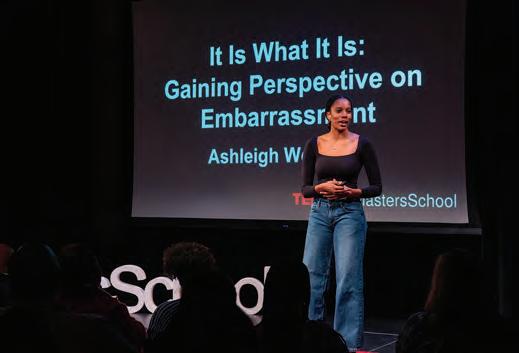
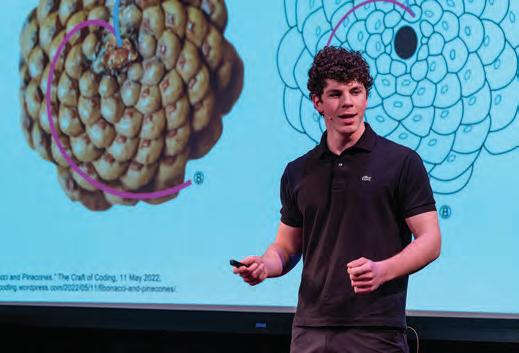


Ashleigh Woodruff ’23 wanted to address a universal experience: embarrassment. In “It Is What It Is: Gaining Perspective on Embarrassment,” Woodruff argued that changing our understanding of this uncomfortable feeling can free people to do what they love, seek out opportunities and enjoy new experiences.
“Embarrassment is just the fear of social rejection,” Woodruff said during her TEDx Talk. “Embarrassment is all in your head.” She outlined three ways that people can move past the unpleasantness of this emotion: “Embrace it, acknowledge that the spotlight isn’t always on you and remember: ‘It is what it is.’”
Woodruff was thrilled when, after she finished, a Masters parent in the audience came up to her and said that the talk helped her feel more comfortable with an upcoming speech she had to give. “This was exactly what I wanted the outcome of my talk to be,” Woodruff shared. “I wanted people to be more confident and comfortable with themselves.”
Elijah Brooks ’24 said that he joined TEDxTheMastersSchool as “an opportunity to explore a topic I was passionate about: self-care.” His talk, “Self-Care: A Gateway to Freedom,” detailed how, through keeping a
journal and discovering the work of Viktor Frankl, a Holocaust survivor, psychiatrist and neurologist, he learned how to care for himself in a meaningful and restorative way.
“Self-care is the practice and the commitment to love yourself,” Brooks said. He encouraged everyone: “Appreciate the present. By appreciating the present, you will give yourself the freedom to become the object of your love.”
For Brooks, the most rewarding part of the TEDx experience was “right after I finished my talk,” he said. “I felt lighter, and to know that my family and friends were watching gave me a feeling I cannot put into words.”
The ideas these 12 students shared on stage will reach an audience far greater than the immediate community. After just 10 days on YouTube, their talks had garnered a collective 3,579 views, with an impact that even Nappo could agree is incalculable.

Oh, what a night! The Fonseca Center was transformed into a star-filled wonderland as the School celebrated the launch of Our Might: The Campaign for The Masters School at the spring gala on April 20. Nearly 450 parents, alumnae/i, trustees and faculty honored longtime trustee Tracy Tang ’80, P’18 and participated in spirited live and silent auction bidding. Among the evening’s highlights were the student string and chamber ensembles and the performers who wowed the guests with their renditions from the album “The Miseducation of Lauryn Hill.”
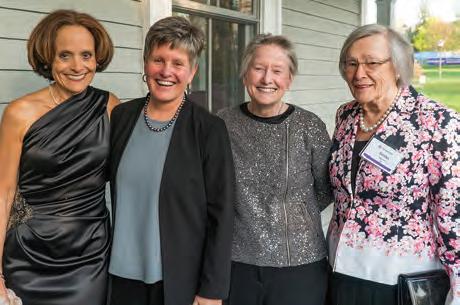
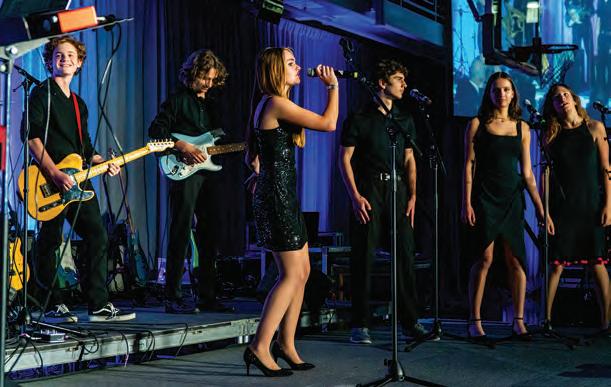


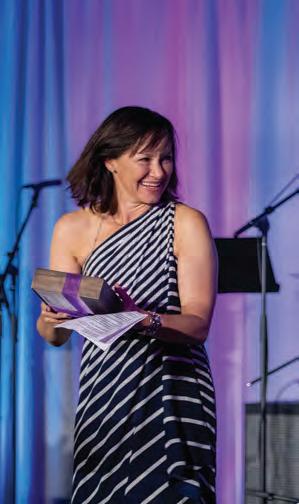
2. Emcees Kara DioGuardi ’88, P’31 and performing arts teacher Curt Ebersole entertained the crowd with song and humor.
3. Eighth grade students took the stage and jammed.
4. Junior class parents Marla Evans and Akil Bello kicked up their heels in celebration.
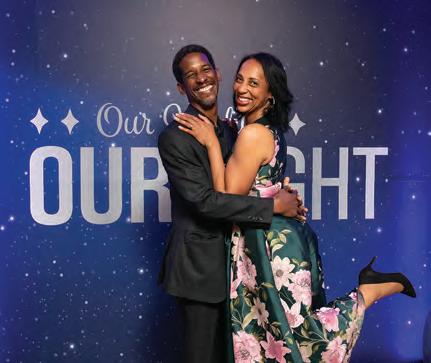
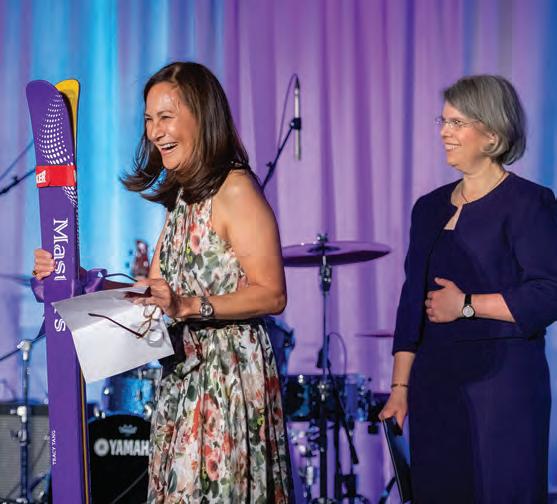
5. Suzie Paxton ’88 (left) and Board Chair Edith Chapin ’83 (right) shared a laugh with Tracy Tang ’80, P’18 as they presented her with a unique pair of Masters skis. Ski with thy might!
6. Let the bidding begin!
7. Alexandra Limpe ’18 (third from left) and other members of the Tang family were delighted to celebrate honorary trustee Tracy Tang ’80, P’18 for her leadership on the Board of Trustees and unwavering support of her alma mater.
8. Trustee Christina Masters Jones, great-great-niece of Eliza Bailey Masters, enjoyed the gala with her uncle Edgar M. Masters H’98, life trustee.

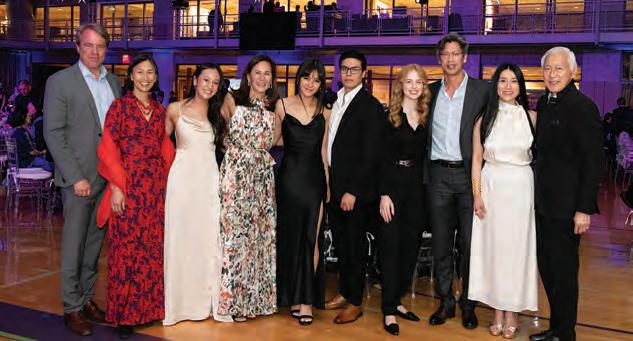

9. Representing the Class of 1993, classmates and trustees Mirna Valerio and Stacey Lacy embraced the evening with open arms.
Chair

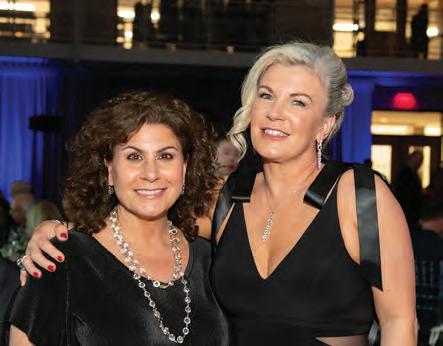
Our Might is the most ambitious fundraising initiative in the School’s 146-year history.
We have already raised more than $90 million for Our Might’s top priorities — transforming our facilities and campus, growing our endowment, and investing in current programs — and have completed three capital projects on budget and on time. Construction of the new Innovation and Entrepreneurship Center is underway, and we have added nearly $19 million to our endowment.
Th E c AM p A ign is A $100+ M illion inv E s TME n T in:
Creating spaces and buildings that will inspire creativity and encourage collaboration.

our community
Delivering innovative educational programs and ensuring that talented students from all backgrounds have the opportunity to access a Masters education.
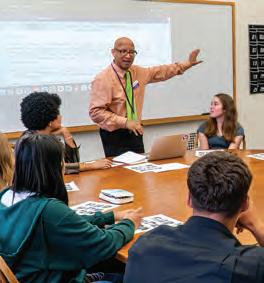
in education.
As we build for the future, we must also elevate support for the Masters Fund to ensure that each student benefits from an exceptional academic program led by talented faculty and enriched by cutting-edge technology and equipment.
Establishing a strong financial foundation to plan for the future and make essential strategic investments.
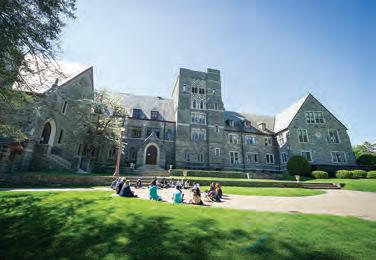
The endowment provides resources, in perpetuity, to give the School the financial freedom to make critical long-term investments.

Our Might is evolving the Masters campus in a way that is reassuringly familiar but boldly new. We are creating flexible spaces that reflect the changing needs of a 21stcentury education and will prepare our students for the world beyond the school walls. Our campus transformation will encourage innovation and will seamlessly integrate academics and community life.
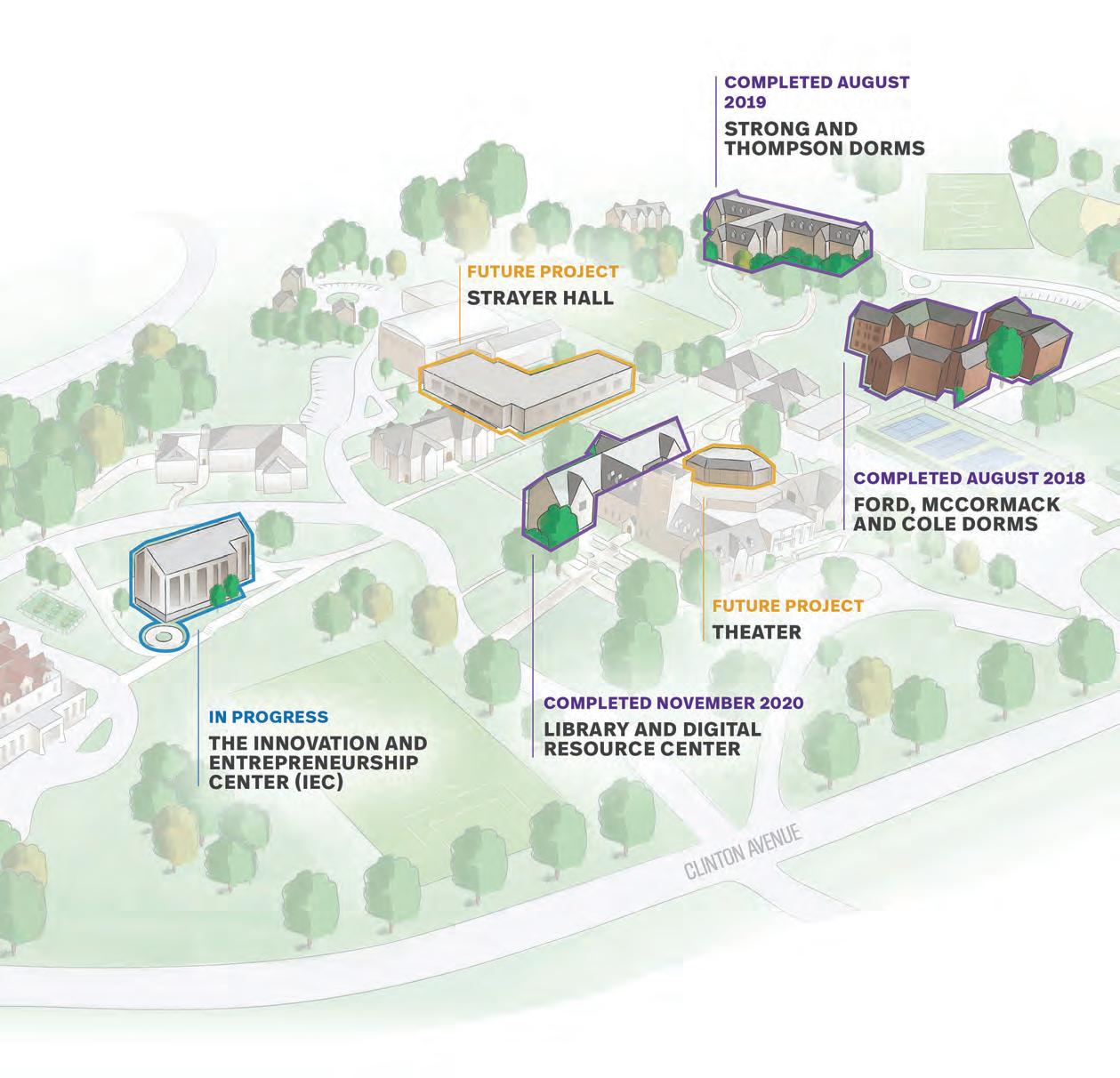
Our Might’s goal is to grow our endowment to $80 million so that it can support 10% of the annual operating budget.
Growing the endowment enables Masters to recruit and retain exceptional faculty and and ensures accessibility for students of all backgrounds. ” “
— Tracy Tang ‘80, P’18, Our Might Campaign Chair
Construction has reached a major milestone: The building is weathertight and drywall is being hung inside. Plumbing, electrical work, and the installation of HVAC equipment, sprinklers and a fire pump continue, as does the installation of the significant technological infrastructure necessary for a state-of-the-art building. The exterior of the building is also nearing a major milestone: the installation of zinc cladding. Over time, the zinc cladding will develop a beautiful greenish patina that will complement the copper-green hue of nearby Estherwood’s cupola. Work this summer will focus on interior fixtures and finishes, and the project is on schedule for hosting classes when students return to campus this fall.
This cutting-edge facility will include, among other things, dynamic classrooms, an innovation lab, a pitch room, and a prototype and modeling workshop. Starting this fall, students will bring this building to life as they engage in pioneering, interdisciplinary programs in innovation, design and entrepreneurship. The IEC will:

C REATE A MULTIFUNCTIONAL , MULTIDISCI p LINARY CREATIVE HUB AND HOME FOR OUR AW ARD - WINNIN g I NNOVATION, E N g INEERIN g AND E NTRE p RENEURSHI p p RO g RAM
STUDENTS AS THEY p RE pARE FOR COLLE g E AND C AREER SUCCESS IN THE DI g ITAL A g E SUPPORT


DELIVER NEW S pACES THAT BAL ANCE S TUDENT E xp L ORATION AND E xp ER T INS TRUCTION, INCLUDIN g AN O p EN -p L AN MODUL AR DE SI g N THAT REIMA g INE S THE H AR k NE SS TABLE FOR THE 21 S T CENTUR Y
Through Our Might we aspire to transform Strayer Hall and the theater to create new teaching and performance spaces, where talented students can thrive and all Masters students can benefit from exposure to creativity and the arts. These spaces will serve as a focal point on campus for our entire community to gather to share in the joy and inspiration of the performing arts.
THeATeR FeATUReS:
• A new orchestra pit and acoustic improvements
• Updated set shop for productions
• New pre-performance gathering area
STRAYeR HAll FeATUReS:
• Formal instruction rooms with digital music recording facilities
• Informal breakout spaces for spontaneous collaboration
• Updated rehearsal rooms
“We need the support of the entire community to ensure this campaign reaches its full potential. We are asking you to help us raise an additional $20 million to deliver on all of our campaign commitments — to create a modern space for performing arts, to bolster the Masters Fund and to grow our endowment.”
– Edith Chapin ’83, Board of Trustees Chair
Supporting student performers and weaving exposure to performing arts for all students into every fiber of Masters life requires a space equal to the students’ hard work, talents and boundless creativity.
— Jennifer Carnevale, Department of Performing Arts Chair


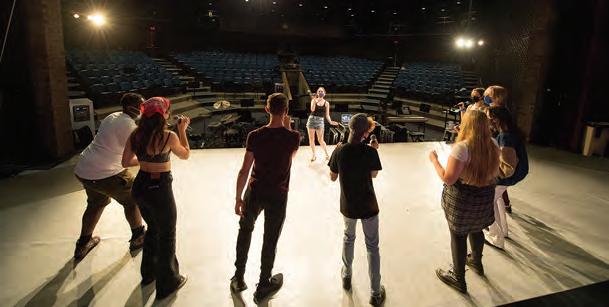

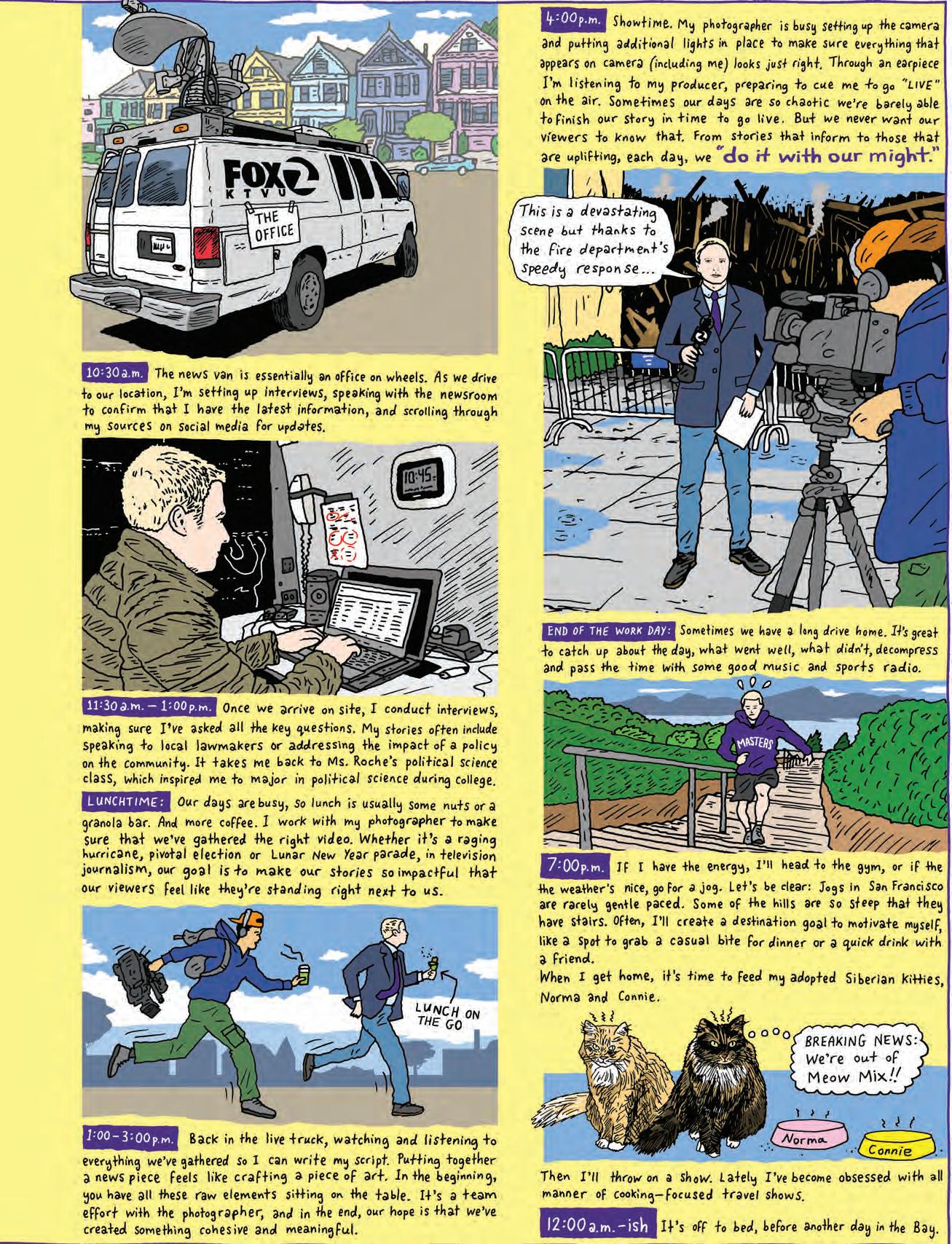

DYLAN PAGeR ’11
is an executive producer of the Pulitzer Prize-winning, Tony-nominated Broadway play “Fat Ham” and the director of producing and creative development at No Guarantees, a theatrical producing office. He earned his B.S. in theater from Northwestern University before getting his start in the business coordinating house seats and ticketing for the original Broadway production of “Hamilton.” At Masters, he served as co-president of Phoenix and Dobbs 16 and appeared in numerous productions.
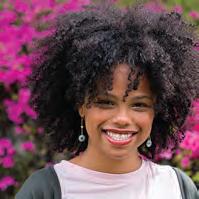
M ORGAN Y O u NG ’ 23
is an eight-year senior who juggles academics with a robust performing arts schedule. She’s a member of Dobbs 16, co-president of Dohters and had leading roles in the fall play, the spring musical and “Macbeth.” She also performed in this spring’s Great Gig. In the fall, Young will study theater and music at the Chadwick A. Boseman College of Fine Arts at Howard University.
What motivated you to pursue a career in theater?
DYLAN: I loved theater from an early age. I remember seeing “Candide,” my first Broadway show, with my mom and grandparents at age 6. I fell in love with theater. I loved the artistry, I loved the entertainment. Any opportunity to see it or participate in it was my heaven. It was through Glee Club, the musicals, Dobbs 16, Phoenix and the classes at Masters that I was able to solidify my love. One of the most transformative experiences I’ve ever had was when I directed a production of “The 25th Annual Putnam County Spelling Bee” at Masters.
MORGAN: I view theater as the foundation of a lot of my growth. I find that oftentimes I shy away from things that are uncomfortable, and it’s hard for me to get out of my own head. Theater helps pull that out of me, and I end up shocked and proud of what I never knew I could accomplish.
Tell us about your first acting experience. D: At 6½ years old, I was in a production of “The Nutcracker” at SUNY Purchase. I was cast as both a mouse and a party guest.
M: My elementary school required us to do a Shakespeare play once we got to second grade. They would switch between “Macbeth” and “Romeo and Juliet” every year. In second grade, I acted in one scene for “Romeo and Juliet.” That was the first time I realized what acting could do for me.
What has been your favorite role to play and why?
D: In eighth grade, I played Snoopy in “You're a Good Man, Charlie Brown” and in tenth grade, I played Bobby Strong in “Urinetown.” Those were great roles. I love the serious stuff, too, but I feel performing
“Suppertime” (from “You’re a Good Man”) and singing the songs in “Urinetown,” which is one of the funniest shows, brought me so much joy. Especially at Masters, where everyone takes everything seriously, it provided a sense of levity.
M: Titania from “A Midsummer Night’s Dream,” because I learned so much about theater during that production in spring 2022. I got to work with more experienced actors who taught me so many lessons that I will continue to let shine through. I also absolutely loved playing Toffee in our winter musical, “Zombie Prom.” I had no idea what I was capable of until that production, and I have never been so proud of my hard work. Everything about the production was so valuable, fun and thrilling.
Describe a theatrical performance that resonates with you.
D: I had such a transformative experience with “Hamilton.” I was lucky to have had so much proximity to that company and to see it before I worked on it. I saw it in previews, and then two weeks later I was working on the production. I felt that show was able to touch and inspire so many people. The first time I sat in the theater and heard the song “Satisfied,” I knew I was experiencing a moment of absolute artistic genius. And then to peel back the layers and have that be the show that taught me so many things about how the business of show business functions was so special.
M: Our spring 2022 production of Shakespeare’s “A Midsummer Night’s Dream” resonated a lot for me because it was double cast. The use of your imagination is one of my favorite aspects of theater and it was really wonderful to see the unique choices made by different actors playing the same characters.
Can one be involved in theater beyond acting?
D: If you love theater, performing is a natural way to be involved, especially in elementary, middle and high school. Through my experience directing at Masters and then at Northwestern (where throughout senior year of college I was still performing in shows), directing and producing, and the artistic direction spoke to me and fueled me. I could still explore my passion for theater from a more analytical business perspective. It was through the marriage of the arts and the business — the artistry and the strategy — that I felt I was using my whole self. And so I sort of stumbled into the management world when someone asked me if I wanted to be on the general management team of “Hamilton.” I said, “I don’t know what that means, but yes.” And it was really through my experience there that I was able to explore what it meant to manage those shows.
M: I would like to explore writing. I love creative writing, and growing up, I used to write plays for fun. I think it could be valuable and exciting to explore that in a more professional way.
What are valuable life lessons you have learned from being involved with theater?
D: I’ve learned a lot about rejection. At Masters, Dobbs 16 was the most important thing for me. When I went to college, I auditioned for 10 a cappella groups and was rejected from every single one. Time and time again, rejected for roles that I wanted, opportunities I was excited about. I think the lesson is resilience, and knowing that if you continue to work hard, stay on track and approach things with kindness, it ends up working out.
M: I’ve learned how to communicate and collaborate with new people. Communication is a very important life skill; it helps you
make connections and shows confidence. To be a good communicator means you have the ability to take control of your life, and I’ve found that people will listen to you.
Fondest memory of Masters?
D: It definitely is Dobbs 16. We did so much traveling. I’m always reflecting upon that. We went to China, we did homestays. We went to Japan. I went to Japan for two summers. I spent three of my four summers of high school in Asia. We performed at Radio City Music Hall, we performed on “The Tyra Banks Show” with the cast of “Glee.”
M: With all the years I’ve been here, it is hard to pick just one. As much as what happens on stage is incredibly rewarding, what happens after is so heartwarming and beautiful. The people that surround me after a performance providing love and affection mean everything to me. Any time I feel overwhelmed by the amount of work I have, I remember that end result, and I’m pushed to work even harder.
Which class or teacher at Masters had the biggest impact on you?
D: Gillian Crane (former associate dean of students and director of Dobbs 16), for sure. She definitely was hugely transformative for me. I still maintain a very close relationship with her.
M: I took American Studies my junior year — that class had the biggest impact on me. Before, I had trouble participating in discussions in a classroom setting. Being thrown into a 30-person discussionbased class put me outside my comfort zone. I had to push myself a lot, and I benefited immensely. I became so much more confident in my intelligence, I valued learning more, and through a yearlong
research paper I wrote, “My Hair, My Choice,” I discovered a lot about my identity and how important feeling secure in that is to me.
Advice for those interested in pursuing theater?
D: Work really hard, see as much theater as you can, read as much as you can, know as much as you can. Never lose your love for it. We are so lucky to do theater. Anything you do professionally becomes very stressful. Remember that there’s a group of artists and people that you’re doing this for. Never lose the passion for it. We’re not saving lives, but we’re enriching them.
M: Take risks! Creativity is so important when pursuing theater, and you can learn so much from using your creativity to push yourself.
If you could play any role or produce any play, what would it be and why?
D: I was interested in doing an off-Broadway, site-specific production of “The 25th Annual Putnam County Spelling Bee.” I felt if we found a gymnasium or an off-Broadway theater where we get a fun, young, dynamic cast, that could run in the same way that “Little Shop of Horrors” has been running for years. Masters was such an inspiration for my falling in love with that show and to produce a show as joyous, fun and exuberant as that one would be incredibly exciting.
M: I would love to play a dark villain or sociopath/psychopath because I think it would be interesting and challenging to play a character so far removed from myself.
Head of upper school, upper school English teacher (Chris)
Middle school math teacher (Anne) 2001-2013
Since leaving Masters, our lives have continued to be very busy as we have resettled into our home in midcoast Maine. Our three children and seven grandchildren all live within 20 miles of us, and we’re fortunate to be able to help out and be involved in their lives.
Chris has been an instructor and we have both been students at Coastal Senior College, an organization that offers a variety of courses taught by the many retired professionals, with diverse areas of expertise, who live in the area. We also volunteer in various capacities. Chris is an active member of the local Rotary Club, as well as a volunteer in a program that helps repair and winterize the homes of low-income members of our community. Anne has a regular shift in a secondhand bookstore, the proceeds of which benefit the local library.
Since we moved back here, we’ve sung with a large choral group,
Middle and upper school French and English teacher, dorm parent 1989-1996
I started my teaching career at Masters as a French teacher and dorm parent — initially in Cole, then in Thompson. My first two children were born on that campus! One of my favorite memories from that period is the annual dorm lip sync contest. Cole won the whole thing one year after I snuck all the language lab headsets out of the language lab so that we could impersonate the singers from the 1985 hit “We Are the World.” It was a moment!
After Masters, I moved between schools in New York and California. For the last eight years, I have been in my second headship, living and working in the East Bay of San Francisco at The Seven Hills School, a preschool through eighth grade school. This is my fourth school after leaving Masters and my 35th year in independent schools — and it all started at Dobbs.
I still love traveling and knitting and have recently begun training for a marathon. My children are now 32 (Hannah), 29 (Alex) and
Tapestry Singers, whose members range in age from teenagers to retirees. Much of the music is challenging, often in eight parts, requiring practice between our regular rehearsals. During the height of COVID-19, we had to meet via Zoom, but we’re now back to rehearsing and performing in person, albeit still with masks.
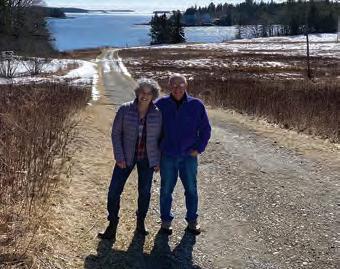
The ocean is our front yard, and we never tire of our view out our windows. We’re still avid outdoors people and take advantage of what our surroundings have to offer: sailing, kayaking and swimming in the summer and fall, and hiking year round. If we get enough snow, there are wonderful trails for cross-country skiing and snowshoeing. When we’re not on the water or on the trails, we’re out in the gardens.
We have fond memories of our 12 years at The Masters School, and we’re delighted when, every once in a while, we run into a Masters alum here in our little village of Round Pond.
23 (Matthew), and my husband, Jihad, is still teaching history. We have four dogs, all doodles!
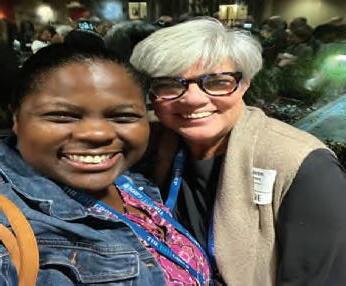
The Masters connections are strong. I still catch up with Kathleen Dill (English teacher and dorm faculty advisor, 1989-1992), on one coast or the other, when we are near each other. I invited Mirna Valerio ’93 to be the keynote speaker at a heads’ conference in Princeton last November, and she brought down the house! On my winter 20222023 sabbatical around the world, I caught up with Stacey Lacy ’93 in Singapore. She is killing it running operations and technology in all of Asia for Citi.
Masters continues to have a strong place in my heart. Thanks to social media, I love following the lives of many students I knew there.
Kathleen and Masters School trustee Mirna Valerio ’93 were all smiles in November 2022.

Reunited and it feels so good! During her recent sabbatical, Kathleen met up with Masters School trustee Stacey Lacy ’93 in Singapore.
In the fall of 1979 Edith Chapin ’83 arrived on the Masters campus as a boarding student and fell in love with the School. Forty-four years later, after 22 years as a board member and six years as chair, Chapin is stepping down from her longtime role.
Her love for the School has not abated. “It’s where I learned how to learn, I learned how to lead, and I learned how to be comfortable with who I am. And that’s priceless,” she said.
Throughout her tenure on the Board, Chapin has seen the School grow — not just in the number of buildings and student population. “It’s a cohesive community,” she said. “And that’s something the Board has been intentional about and focused like a laser to make sure to never lose those qualities of community.”
Beth Nolan ’69, vice chair of the Board, said: “Edith Chapin has led the Board with her special combination of incisive thinking, good sense and genuine wisdom, and always with the interests of the Masters community and the secure future of our School in mind. It has been a true pleasure to serve on the Board under her outstanding leadership.”
Chapin has worn many hats in the Masters community: alumna, member of the Alumnae/i Advisory Committee and Dobbs Alumnae/i Association Board, vice chair of the Board of Trustees and head of the search committee for current Head of School Laura Danforth. “In the time I’ve
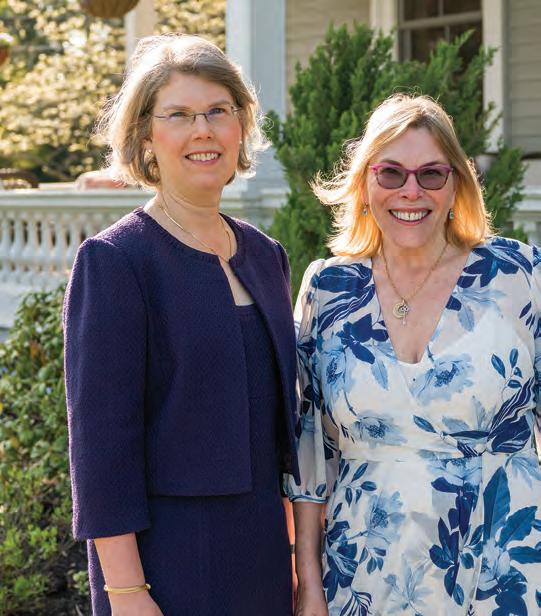
been on the Board, we’ve had one head for 15 years, and now we’ve had the other for eight,” Chapin said. “That’s a sign of a healthy community.”
After graduating from Masters, Chapin headed to the Medill School at Northwestern University to study journalism. “Journalism was something that I had grown up around,” she said. It was just very natural. In the mind of a teenager, it was exotic compared to political science.”
In tenth grade at Masters, Chapin was in charge of layout for the student-led newspaper Tower, but she turned her journalistic pursuits to radio in college.
“I was doing newscasts and my friends would tease me and say, ‘Okay, you need to slip in a coded word for us,’” Chapin recalled. Her friends wanted her to use the word “glorious,” and she was able to honor their request only once in the spring when the weather was “actually glorious.”
From Northwestern, she was off to an internship at CNN. The journey from intern to vice president and deputy chief of CNN’s Washington, D.C., bureau included a tour of duty in the London bureau as a field producer and assignment manager,
producing news stories in Europe, the Middle East, Latin America, and Africa. Chapin also managed the New York bureau as deputy chief and managing editor during the September 11 terrorist attacks. Moving from strength to strength, she joined NPR in 2012 as chief international editor and now serves as interim senior vice president of news and editorial director.
Chapin’s career as a journalist influenced how she approached her board service. “I tried to bring the journalist’s ability to look at things with a little bit more of a wide shot and bring different workingworld experience,” she said.
Noting that the field of journalism “needs talented, devoted, curious, dedicated journalists for our industry to thrive and survive,” Chapin has relished her role as mentor to Masters students interested in the profession. “I’m happy to pay it forward.”
Chapin is also happy to continue helping the Board, the School, or any student. “I’m not disappearing,” Chapin said, “but I am looking for a little bit of a break, and I’m going to enjoy that.”
1. Nearly eight decades separate these two Dobbs Athletic Association presidents, but Ashleigh Woodruff ’23 (left) and Ann Atkins Clark ’44, recipient of the Eliza Bailey Masters Fellowship Award, found plenty to talk about.
2. It was a weekend of hugs.
3. Members of the Class of 1993 commemorate beloved classmate Carrie Barcus at a tree planting.
4. Ann Atkins Clark ’44 accepts the Eliza Bailey Masters Fellowship Award during the banquet in the Fonseca Center.
5. Left to right: Leslye Lynford, Viki Randall Kaczkowski and Rikke Borge, all from the Class of 1973, share a laugh as they look at photos from their Dobbs days.
6. Betsy Thorndike Wilson ’58 (left) and Susie Marckwald Mackay ’58 were delighted to be back on campus.
7. What better way to celebrate a 40th reunion than with friends and a jazz brunch at Estherwood?
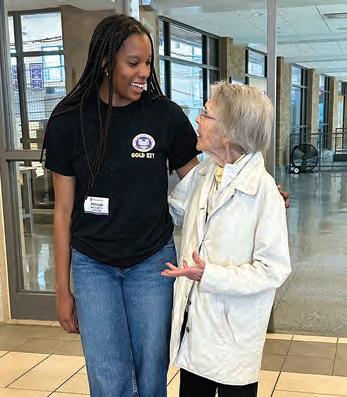
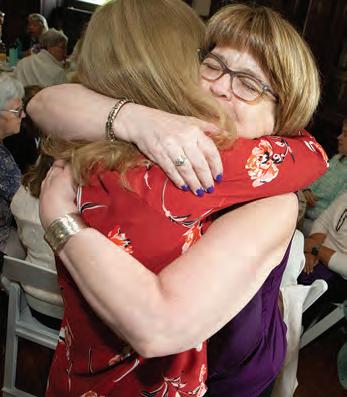
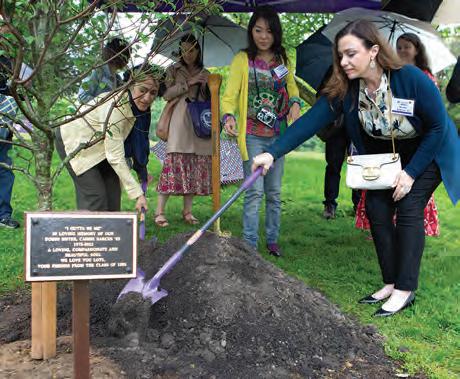


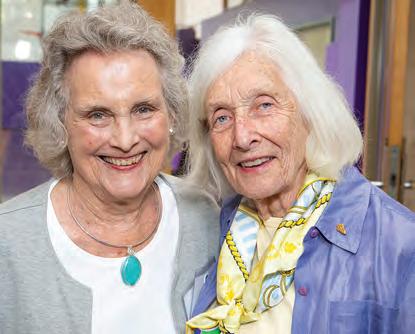
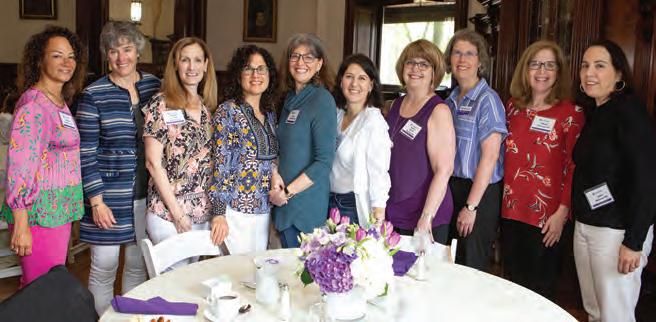
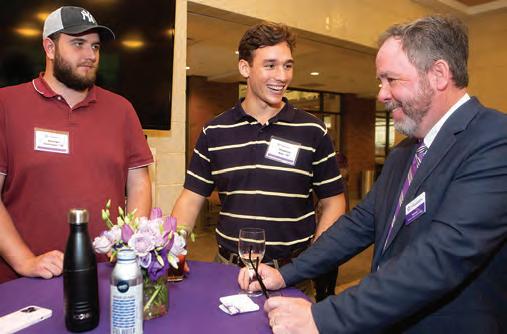
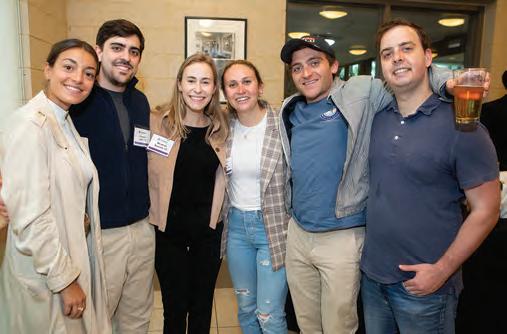
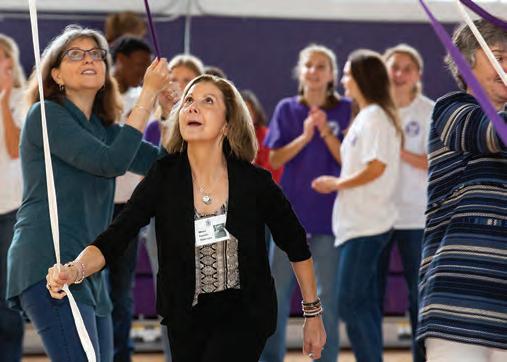
It is tradition at Reunion to honor members of The Masters School community who have distinguished themselves through service to the School, to its students, and to the world outside Masters.
Congratulations to the following award recipients.
The Eliza Bailey Masters Fellowship Award
Ann Atkins Clark ’44
The Anna Howe Faculty Award
Matthew Ives, upper school history and religion chair
The Richmond Bowl
edith C. Chapin ’83
The Arts Hall of Fame
Kara DioGuardi ’88
The Athletics Hall of Fame
1993 Volleyball Team
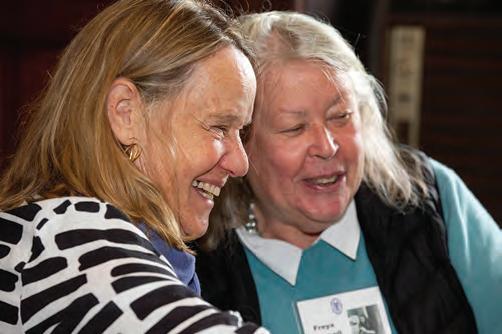

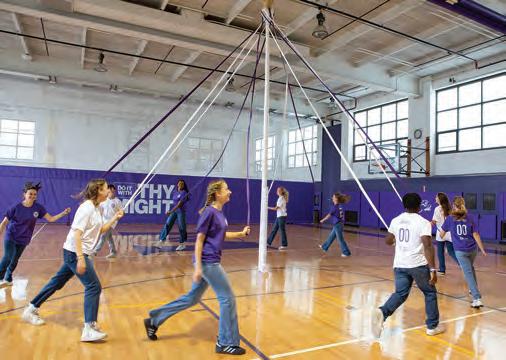
8. George Corrigan and Stephen Boe, both from the Class of 2018, enjoy catching up with Matthew Ives, upper school history and religion chair and the Anna Howe Faculty Award recipient.
9. Tracey Shafroth ’73 (left) and Freya Darvall Newman ’73 were all smiles.
10. Celebrating 10 years: Cheers to the Class of 2013.
11. The Class of 1973 marks 50 years.
12. It wouldn’t be a Dobbs reunion without a Maypole.
13. Teaching the next generation how to Maypole.

Annie Barch ’07 remembers meeting Mike Watts ’07 in either Lee Dieck’s chemistry class or Peter Smith’s history class. “In my head, I have this vision of Mike choosing to sit next to me rather than vice versa,” Annie recalled with a wink.
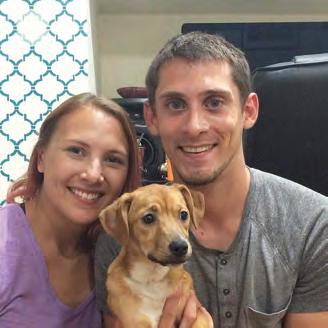
The two were friendly throughout their time at Masters; they both participated in the upper school musical “Hello Dolly,” but didn’t interact much off campus. “We had separate paths,” Mike explained. ”We only really had our time in class together.”
Fast-forward six years after graduation when Mike made a bold move. “I was thinking about people in my life I could reach out to and build a connection with, and Annie popped into my head. I messaged her on Facebook,” he said.
“And we kind of never stopped talking,” she added.
In a full-circle moment, Mike proposed to Annie the day after they attended their 10year reunion at Masters. During the event, Mike couldn’t contain his excitement and told classmates about the surprise proposal, which left Annie wondering why everyone was giving her “weird looks.” Mutual friend Chris Makris ’07, who attended the couple’s 2019 wedding, was supportive right from the start. “He knew both of us separately. He’s our rock,” Annie said.
Tanya Welsh Koshar ’04 and Jonathan Koshar ’03 can thank their Masters pal Matt Chambers ’03 for bringing them together.
“Matt threw a little party to celebrate my return to New York from Arizona,” Jonathan said. “He invited a bunch of people, including Tanya. He once told me ‘Y’know, you and Tanya would be good together.’”
Matt cleverly sent Jonathan to pick up Tanya for the Friday night group dinner, and that’s when they started to click. “We didn’t start out sitting next to each other for the meal, but we somehow ended up next to each other and sharing food from each other’s plates,” Tanya said. “I hadn’t seen him in years, but it felt like I had known him forever.”
The mini-Masters reunion turned into a whirlwind of a weekend. “By Sunday, I was meeting his mom, his sister and his best friend from fifth grade,” Tanya recalled. “That was July 2017; by September I moved to Arizona and we got married in March of 2018. We welcomed our first child in 2019 and are expecting our second child this spring.”
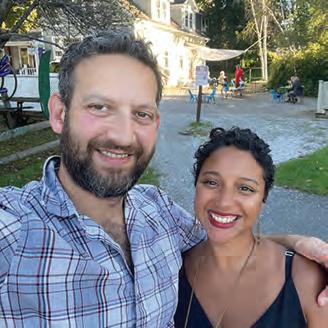
Alana Altmann ʼ03 and Alex Chehebar ʼ02
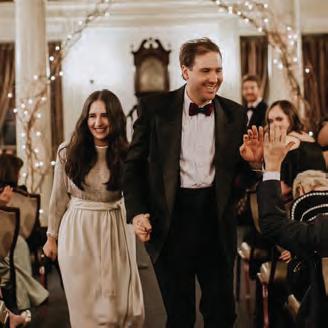
The first encounter between Alex Chehebar ’02 and Alana Altmann ’03 happened in the dining hall. “I was immediately infatuated — laser focused,” Alex explained. “I found her very intimidating but kind of alluring.”
Alana had a different recollection. “I remember Alex was going around using the phrase ‘curb your enthusiasm,’ and I called him out on it because I knew that was a new TV show coming out, but nobody else seemed to know, and so I kind of blew up his bit.”
The humorous, playful banter between them was the beginning of a solid friendship. “We were best friends for the entirety of high school,” Alana said.
Love soon blossomed, and they went on their first date in 2003. “After Alex graduated, we went on a road trip and that was a turning point,” said Alana. “We dated and then we broke up as young people do, but we reconnected 10 years later.”
The couple started dating again in 2014 and eventually tied the knot in 2018. When they reminisce about their time at Masters, Alana acknowledges that she is grateful to have learned the value of artistic expression. Ever the comedian, Alex grasped a different life lesson. “Masters taught me that you can find your wife there,” he joked.
Jayda Leder-Luis ’07 and Charlie Siegler ’07 met in ninth grade in Ron Rothenberg’s advisory group. Playing basketball, going to the movies, and hanging out on weekends were par for the course for the pair. “Being part of the Masters community, our families got to know each other,” Jayda said. “I went to all his birthday parties and he went to mine.”
They were both athletes who saw each other every day, but their bond didn’t turn romantic until 2008. “We went off to college and had the first semester apart, but we still kept in touch,” Charlie explained. “When we came back for spring break we decided to just go for it.”
The Boston lovebirds married in 2018 and remain forever indebted to Masters. “We grew as friends there, and that has been so important as to how we continue to respect each other and how we communicate with each other,” Jayda said. “We have that shared experience and those shared values that are deep in our young lives.”

Jayda Leder-Luis ʼ07 and Charlie Siegler ʼ07
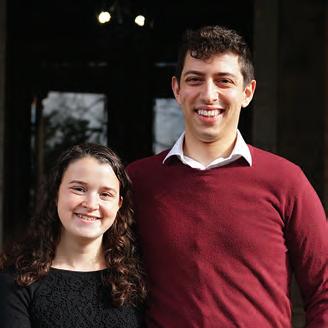
For Class of 2012 alumni Andre Adams and Chloe Lazarus, love began en route to the Masters campus.
“We met at the Croton Harmon station because we were both commuters,” Andre said. “I would transfer from the train to Dobbs Ferry at Croton and that’s where Chloe would get on.”
Being together in Christopher Allen’s physics class, Marianne Van Brummelen’s calculus class and Eric Shapiro’s U.S. history class brought the two close until one day changed everything.
“I cornered her in a library cubby and kind of mumbled a sheepish ‘prom-posal,’” Andre said.
While Chloe admitted the ask wasn’t a “big production,” the date is forever ingrained in her memory. “On May 7, 2011, Andre asked me to prom, and that’s where it all started,” she exclaimed. “Been together ever since!”
The Manhattan couple exchanged vows in 2022 and say that their Masters performing arts experiences and mutual love of the Harkness method are special memories. “We’ve known each other for so long, and we’re not the same people we were in high school, but we were able to grow together and not lose our individuality,” Chloe said.
ADORMS yOu LivED iN AT DOBBS
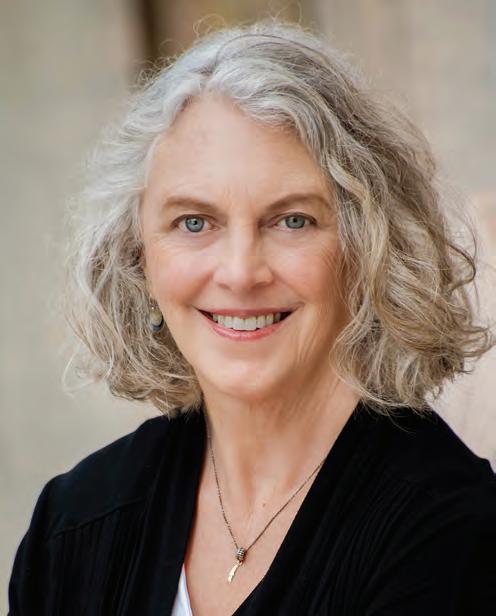
Third House (grade 9), Second House (grade 10), Thompson (grade 11) and Estherwood (grade 12)
DELTA OR PHi
Delta!
Ann Batchelder’s forthcoming memoir, “Craving Spring: A mother's quest, a daughter's depression, and the Greek myth that brought them together,” will be published in October by legacy Book Press. For more information, please visit annbatchelder.com.
FAvORiTE CLASS AT DOBBS
So many! Ethics and Philosophy (Miss Berry), History of Jazz (Mr. Pierpont), Miss Newman’s English class…
FAvORiTE SONg yOu SANg WiTH DOHTERS
“Helplessly Hoping” by Crosby, Stills & Nash
FiRST BOOk THAT iNSPiRED yOu
“ The Diary of Anaïs Nin” by Anaïs Nin
FAvORiTE AuTHOR
I love many authors, but Pema Chödrön’s books saved me again and again.
BOOk CuRRENTLy ON yOuR NigHTSTAND “Lessons in Chemistry” by Bonnie Garmus
BEST ADviCE yOu’vE EvER RECEivED “Keep your mouth shut and your mind open.”
WHO iNSPiRED yOuR iNTEREST iN THE ARTS?
I grew up in a small town in Illinois, so coming to a private girls school near New York City in 1967 really opened my mind. Mr. Pierpont, the music director, encouraged me to study voice, and when I was president of Dohters, he helped us make an album. I went to Europe for the first time when he took the Glee Club. The Religion Department faculty pushed us to think critically, and my English teacher, Miss Newman, introduced us to Black literature and women’s literature. She also had us keep a journal, which is something I have continued to do off and on since Dobbs.
WHAT LESSONS FROM DOBBS DO yOu CARRy WiTH yOu TODAy?
Dobbs was the first time I saw girls in leadership roles, which encouraged me to stand up for myself. As boarders, we also looked out for each other; I learned to cherish female friendships as a result.
yOuR MEMOiR, “CRAviNg SPRiNg,” iS THE STORy OF gROWiNg AS A MOTHER AND LEARNiNg TO SuPPORT yOuR DAugHTER THROugH HER DEPRESSiON AND ADDiCTiON. WHy WAS iT iMPORTANT TO SHARE THiS ExPERiENCE WiTH THE WORLD?
I thought everything was fine in my family. My two kids were doing well with school and activities. Then one day, my 16-year-old daughter told me she had suicidal thoughts and admitted to an eating disorder (which morphed into drug addiction in college). I was totally blindsided. I felt devastated and confused during those years and had to reassess everything I thought I knew about depression, addiction, recovery, motherhood and myself. I wrote the book so mothers (I use this term inclusively to mean “all who identify as mothers/ caregivers”) struggling to raise troubled teens might feel less alone. I also wanted to help reduce the stigma around mental health and addiction and encourage women of all ages to discover ways to trust themselves.
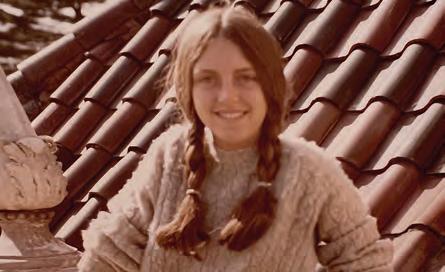
WHAT DiD yOu LEARN ABOuT yOuRSELF WHiLE WRiTiNg
“CRAviNg SPRiNg”?
When I first started writing, I thought the book would be about my daughter’s pain, but later I realized it was really about me. Where did I develop my expectations about motherhood? What helped me learn to believe in myself? And how did I need to change?
WHAT WAS THE MOST CHALLENgiNg PART OF WRiTiNg
“CRAviNg SPRiNg”?
I had a burning desire to write this story to help me understand what had happened in our family and my role in it — but I would never have looked for a publisher if my daughter was not okay with that. When I gave her my manuscript to read, I was nervous. She cried over certain passages, but after she finished, she looked up and said, “This is a love letter to me, isn’t it?” That was the best endorsement anyone could have given me. She encouraged me to publish, and I invited her to write the epilogue.
WHAT WAS THE MOST SuRPRiSiNg PART OF THE WRiTiNg PROCESS?
I wanted to include the Greek myth about Demeter and her daughter, Persephone, in my memoir. I’d always felt connected to Demeter as a role

model, but I didn’t know how to incorporate this. Reimagining the myth in short chapters and then drawing parallels to my experience as a traumatized mother helped me develop the story arc that had been eluding me. After that, the memoir kind of wrote itself.
WHAT DO yOu HOPE PEOPLE TAkE AWAy FROM “CRAviNg SPRiNg”? What I learned from my experience is that we are all on the spectrum of addiction, in that we are attached to certain outcomes. We “crave” a happy ending for our children, for ourselves. But life doesn’t always work out that way. Sharing stories helps us heal and recover from the need to be perfect and fosters compassion for ourselves and others.
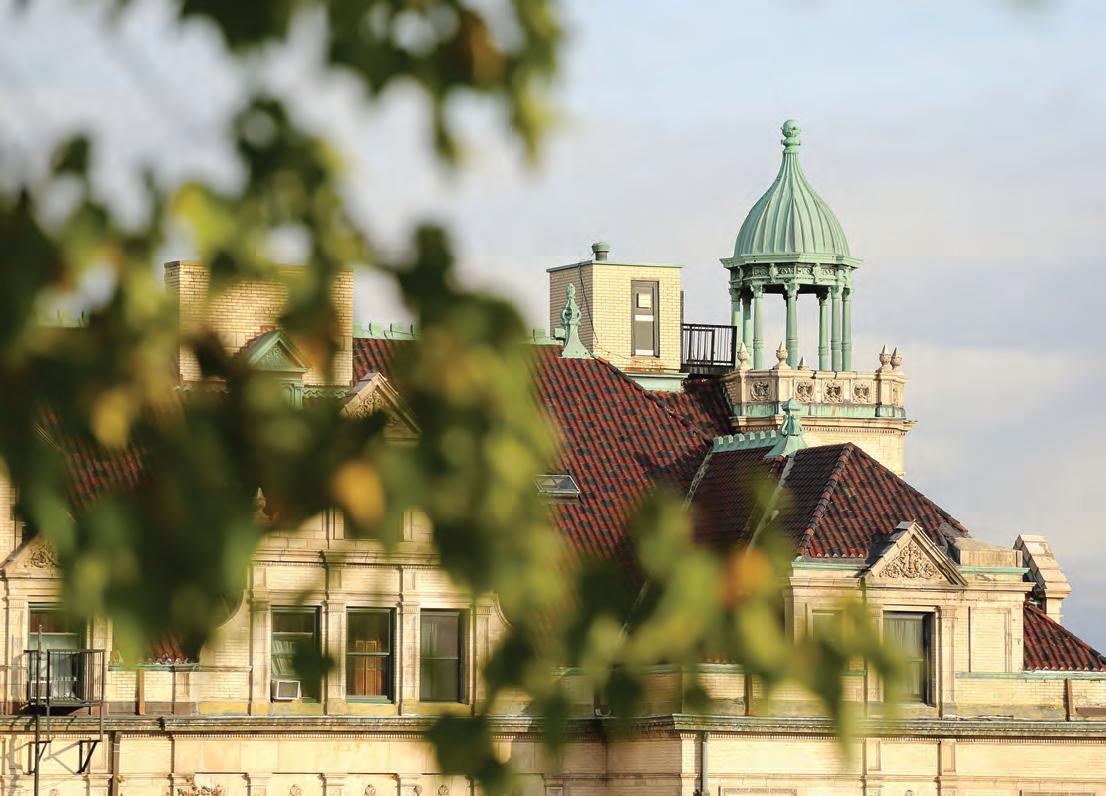
For generations, our community has come together in support of the
This annual initiative enriches the entire Masters experience, allowing each student to live the School's motto, do it with thy might, every time they step foot on campus.
To make your gift, visit mastersny.org/makeagift or contact Director of Annual giving Hilary Finkelstein at 914-479-6510 hilary.finkelstein@mastersny.org
This spring, Masters hit the road to visit with alumnae/i across the country.
1. Bonney Armstrong ’83, Jessie Goldfarb ’77 and Randi Gronningsater Stroh ’67 (left to right) had brunch at The Kitchen American Bistro in Boulder, Colorado.
2. Alumnae/i met at the Denver Art Museum in March for a tour of the Western Collection led by docent Ellen Woods Reynolds ’67. Left to right: Bonney Armstrong ’83, Janey Weadock Hanley ’67, Barbara McLaren Boucher ’46, Jason Holzberg ’17, Ellen Woods Reynolds ’67, Maria Rivellino-DeVelara ’84, Chris Patrello ’04, Mallory Bernstein ’04 and her daughter, Associate Head of School for Institutional Advancement Seth Marx, and Stuart Kassan, brother of Maralind Kassan Heilman ’63.
3. Hannah Miller ’10, president of the Dobbs Alumnae/i Association Board, hosted a gathering in Washington, D.C. Left to right: Mary-Stuart “Missy” Martin DeCamp ’77, Lucas Buyon ’11, Alexandra Jumper ’08, Hannah Miller ’10, Gabriela Aguirre ’89, Patricia (Tia) Saul Lotuff ’89, Jeannette Windon ’89, Wen Ni ’15 and Lizzie Edgeworth Cantacuzene ’78.
4. Alumnae/i took a distillery tour at the Family Jones Spirit House in Denver. Left to right: Individual Giving Officer Carol Maxwell; Bonney Armstrong ’83; Andreas DeVelara, son of Maria Rivellino-DeVelara ’84; Jason Holzberg ’17; Jason’s friend Adam; and Maria RivellinoDeVelara ’84.
5. Former trustee Cinnie Ferris Evans ’52, seated, former trustee and Dobbs Alumnae/i Association board member Cassy Evans West ’86, and Cassy’s husband, Jonathan, hosted an alumnae/i event at the Quail Valley River Club in Vero Beach, Florida. 4
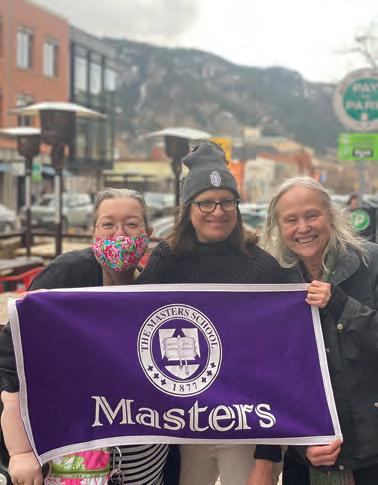
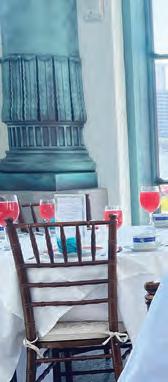
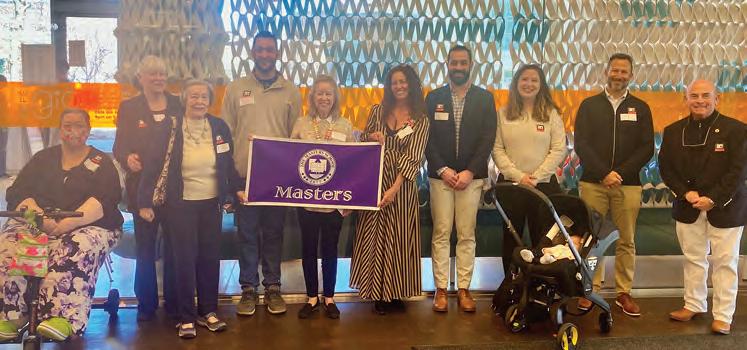
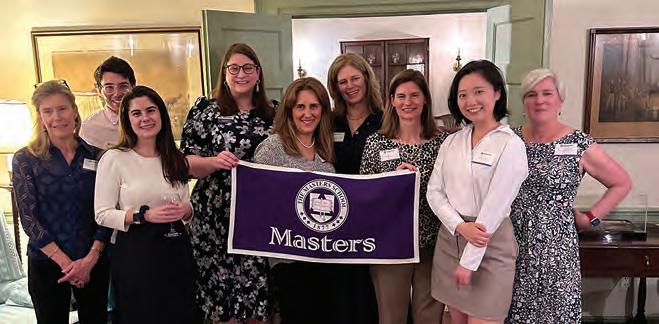

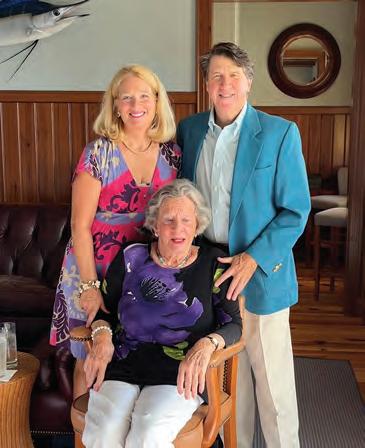
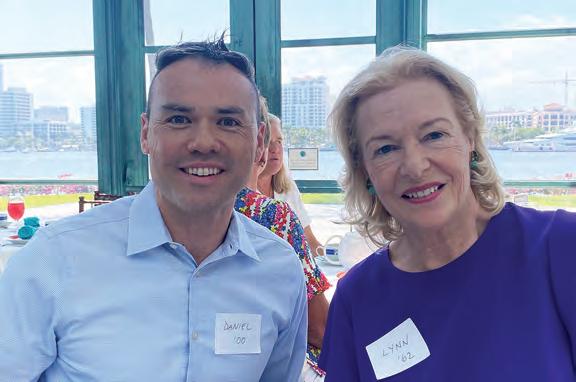


6. Daniel Low ’00 and Lynn McGrath Tone ’62 enjoyed lunch after a private tour of the Henry Morrison Flagler Museum in Palm Beach, Florida.
7. Alumnae/i had cocktails on the water at the Quail Valley River Club in Vero Beach.

Seated: Former trustee Cinnie Ferris Evans ’52 Front row, left to right: Terry Trimble, husband of Joan Whipple Trimble ’64; Betsy Boyce Hoover ’66; Pamela Charlston De Grood ’86; former trustee and Dobbs Alumnae/i Association board member Cassy Evans West ’86; Joan Whipple “Whippie” Trimble ’64. Back row, left to right: Roger Jones, husband of Chrisy Masters Jones; trustee Chrisy Masters Jones; Jonathan West, husband of Cassy Evans West ’86; Francis Schwerin, husband of Betsy Hubbell Schwerin ’53; Pamela Rowe ’70, Rosamond “Roz” Allen ‘63; Paul Landry, husband of Rosamond Allen ’63; Betsy Hubbell Schwerin ’53, Sujata Jaggi ’01.
8. Asema Ahmed ’96 and her husband, Ozi Amanat, took in the Heat vs. Knicks game in Miami, Florida.
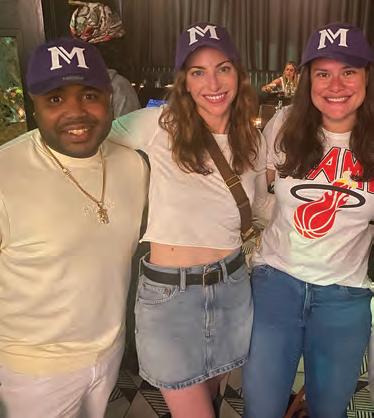
9. Alumnae/i at the Pavilion at the Henry Morrison Flagler Museum, which houses Flagler's original private railcar. Left to right: Susie Anderson, friend of Leslie McGuirk ’78; Leslie McGuirk ’78; Jeanne Schwarz Behre ’71, Patricia Underwood ’71, Lynn McGrath Tone ’62, Daniel Low ’00 and his wife, Stephanie; and Sujata Jaggi ’01.
10. Left to right: David Adams ’07, Lindsay Agranoff Gunia ’00 and Sujata Jaggi ’01 at the Jaguar Sun pregame event in Miami before the Heat vs. Knicks game. 6 7 8 9

died at the age of 94 on October 6, 2022.
Penny made her way to Dobbs by way of West Virginia. Her sister, Isabelle “Dibbie” Spurr Appleton, followed in her footsteps, graduating in 1956.
After receiving a degree in English from Smith College, Penny applied to Harvard Business School but was turned down because the school did not accept women at the time. She applied and was admitted to Harvard Law School but deferred and moved to New York City with friends. There, she met the man who would become her husband of 44 years: Julian Howard “Howdy” Marshall, Jr. Together, they raised five children and lived in Irvington, New York, and later in Biddeford Pool, Maine.
A throughline in Penny’s life was service to her community — especially her beloved alma mater. In seven-plus decades, she held a number of important roles at Dobbs: trustee (1981-1987), president of the Alumnae Board (1975-1978), chair of the Annual Fund and class notes editor. She is one of few alumnae to have won both the Eliza Bailey Masters Fellowship Award (1995) and the Richmond Bowl (1981).
Penny volunteered with the Junior League and her local churches. She was a passionate gardener and over the course of her life was involved with the Irvington Garden Club, the Piscataqua Garden Club and Garden Club of America.
In her 80s, Penny took up an unexpected hobby: blogging. Her online missive, “Nearly Ninety” (nearlyninety.wordpress.com) debuted in May 2017. Over the course of five years, she wrote dozens of posts on topics about friends, family and gardening — and a lifetime of lessons learned.
She was predeceased by her youngest son, Alex (January 2022); her husband, Howdy (1997); and her younger brother, Benjamin Moore Spurr (1993). Penny is survived by four children, Tad, Clint, Julia and Margaret; seven grandchildren; and her younger sister, Dibbie.
The Masters School notes with regret the passing of the following members of the extended Masters School family.
FACULTY
Adrienne w. rudge
Director of Publications, 1988-2001 December 10, 2022
Kaarina Ederma Head Librarian, 1981-1988 November 21, 2021
1930 s
Yvonne gaston tipson ’37 January 10, 2023
dorothy Mower bergland-Anderson ’38 June 20, 2020
barbara Engh Croft ’38 July 26, 2022
Marjory brenneman herfurth ’38 May 3, 2018
hope Langford turney ’38 December 11, 2022
1940 s
Vesta tittmann McLean ’40 September 22, 2022
Marion Smith turner ’40 January 1, 2023
Eunice powell grover ’41 October 8, 2019
penelope Spurr Marshall ’45 October 6, 2022
Jane E. westerveldt ’45 October 14, 2022
nancy riford turner ’46 October 4, 2018
nancy Levis williams ’46 October 26, 2022
Edith binney Metcalf ’48 August 10, 2022
nancy Ewing nye ’48 October 23, 2022
Vera potter whistler ’48 October 23, 2022
barbara group wright ’48 November 27, 2021
bonnie Kazanjian Yarrington ’48 August 9, 2022
Ann giammattei Schwing ’49 September 11, 2022
1950 s
Louisa gilbert Alexandre ’54 October 1, 2019
Elizabeth heminway dineen ’54 December 8, 2022
Jennifer winston pierson ’55 September 29, 2022
Sandra Sargent holcombe ’57 September 21, 2022
Charlotte forbes trotter ’57 January 7, 2023
Mildred baxter perkins ’58 December 8, 2022
Louisa Zimmerman Smyth ’58 July 30, 2022
Alexandra noble Swift ’58 January 22, 2023
nancy weston wells ’58 March 16, 2022
1960 s
Susan deshler Craig ’62 October 14, 2022
Carol Connett farman ’63 October 25, 2022
Elizabeth Zug Johnstone ’63 July 9, 2022
Susanne Curtis deane ’66 November 14, 2022
1970 s
Susan E. Joslin ’70 November 7, 2022
THE MA g AZINE OF THE MASTERS SCHOOL
Laura Danforth Head of School
Meredith Halpern Associate Head of Strategic Communications
Isaac Cass Digital Communications Coordinator
Christina Ha Communications Associate
Jen Schutten Associate Director of Communications
Design: KBWhite Communications LLC
Seth Marx Associate Head for Institutional Advancement
Judy Donald Advancement Associate
Hilary Finkelstein Director of Annual Giving
Sydney Hummel Advancement Assistant
H EAD OF S CHOOL
Laura Danforth
BOARD OF TR u S TEES
Edith C. Chapin ’83, Chair
Beth Nolan ’69, Vice Chair
Katherine A. Henry ’94, P’25, ’29, Treasurer
Dana W. Oliver P’22, ’25, Secretary
Laura Danforth
Michael Greene P’10, ’13
Ronen Israel P’23
Christina Masters Jones
Philip Kassen
Susan Katzke P’24
Stacey Lacy ’93
ZhiFeng Li P’22
Sydney Shafroth Macy ’70
Steve Marlowe P’23, ’23, ’25
Edgar M. Masters H’98, Life Trustee
Hannah Miller ’10
Allison Moore ’83, P’17, ’19, ’24
Susan Follett Morris ’57, Life Trustee
Brooke Nalle P’24, ’27
Hillary A. Peckham ’09
Rajiv Ratan P’22, ’24
Jonathan Resnick P’26, ’29
William Roberts
Steven Safyer P’04, ’07
Tracy Tang ’80, P’18
Mirna A. Valerio ’93
HONORAR y TR u S TEES
Marin Alsop ’73
Cynthia Ferris Evans ’52, P’76, ’86
Jeannette Sanford Fowlkes ’58, P’87
Ruth Mitchell Freeman ’51
Nancy Maginnes Kissinger ’51
Claudia Boettcher Merthan ’51
Lynn Pilzer Sobel ’71, P’99, ’05
DOBBS AL u MNAE/ i ASSOC i A T i ON BO ARD
Hannah Miller ’10, President
Ricardo Oelkers ’03, Vice President
Justina Michaels ’02, Clerk
Natasha Bansgopaul ’04
Lucas Buyon ’11
Sharon Nechis Castillo ’84
Karen Feinberg Dorsey ’84
Austin O’Neill Dunyk ’98
Kathryn Taylor Harvill ’95
Jodi Innerfield ’05
Vincent Madera ’05
PARENT ASSOC i AT i ON E x EC u T iv E C OMM i TTEE
Officers
Brooke Nalle P’24, ’27
President
Madeline Seguinot P’20, ’24
Co-Vice President, Upper School
Monaqui Porter Young P’23, ’25, ’27
Co-Vice President, Upper School
Parke Anderson P’24, ’27
Co-Vice President, Middle School
Midori Im P’22, ’28
Co-Vice President, Middle School
Committees and Chairs
Saloni Singh P’27
Admission Support Chair
Brandi Maniscalco P’24
Boarding Parent Representative
Nadia Reid-Christie P’23, ’25
Boarding Parent Representative
Roxanne Todor P’21, ’23
Book Club Chair
Tracelyn Charles P’26
Co-Chair, Diversity, Equity and Inclusion Committee
Madeline Seguinot P’20, ’24
Co-Chair, Diversity, Equity and Inclusion Committee
Susie Williams P’26
Co-Chair, Diversity, Equity and Inclusion Committee
Carol Maxwell Individual Giving Officer
Maryann Perrotta Database Administrator
Mary Ryan ’00 Associate Director of Institutional Advancement
Amie Servino ’95, P’26 Director of Parent Engagement
Andrew Barnes P’26, ’26
Masters Fund Parent Chair
Jordana Manzano P’23, ’26
Parent Program Committee Chair
C lass Representatives
Parke Anderson P’24, ’27
Sara Barek P’27, ’29
Marielys Divanne P’24
Marla Evans P’24
Susan Furniss P’20, ’23, ’25
Midori Im P’22, ’28
Staci Marlowe P’23, ’23, ’25
Jenny Liang Milward P’24, ’26, ’29
Lori Moussapour P’15, ’25
Jennifer Nappo P’21, ’23, ’23
Jennifer Neren P’28
Joelle Resnick P’26, ’29
Shelly Steinwurtzel P’26, ’30
Latasha Thomas P’25, ’30
Paula Wood P’26
Steven Yung P’23, ’30
06

16
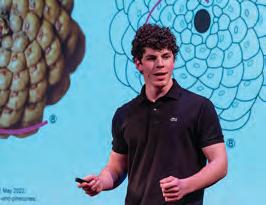
1,497,147
Not everyone can start a sentence with "That time I met Gloria Steinem," but Treasure Brooks ’17 can.
Number of views TeDxTheMastersSchool talks have gotten on YouTube (as of May 5, 2023)
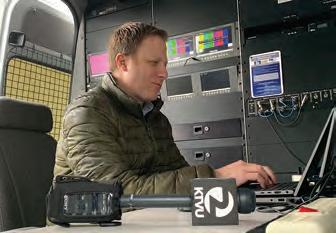
32

When Zak Sos ’99 needs a break from breaking news, he hits the slopes in Tahoe City — a mere 756 miles from Jackson Hole, Wyoming, where Melissa Malm ’73 made history.
A match made in Masters Hall: Who will be the first Masters couple to name their child eliza Bailey?

The Grand Opening of the Innovation and Entrepreneurship
Check your inbox in the coming weeks for an invite to this exciting event to be held in Fall 2023.
Join special guests and the entire Masters community to celebrate the ribboncutting ceremony for the new IEC building, our pioneering new facility representing the School’s commitment to excellence and innovation in education. For more information, please contact Mary Ryan ’00, Associate Director of Institutional Advancement, at 914-479-6433 or mary.ryan@mastersny.org.
